Discovered in 1859, the Comstock Lode of Nevada was one of the world’s richest deposits of precious metals, and the mining bonanza that occurred there is one of America’s most significant historical events.
This was a place where remarkable achievements of mining, engineering, and logistics occurred on a daily basis. Much of this activity occurred very early in the development of the mining West, often decades before the great bonanzas in other states.
This collection of images captures the incredible towns, mines, and mills of this magnificent era of western mining.
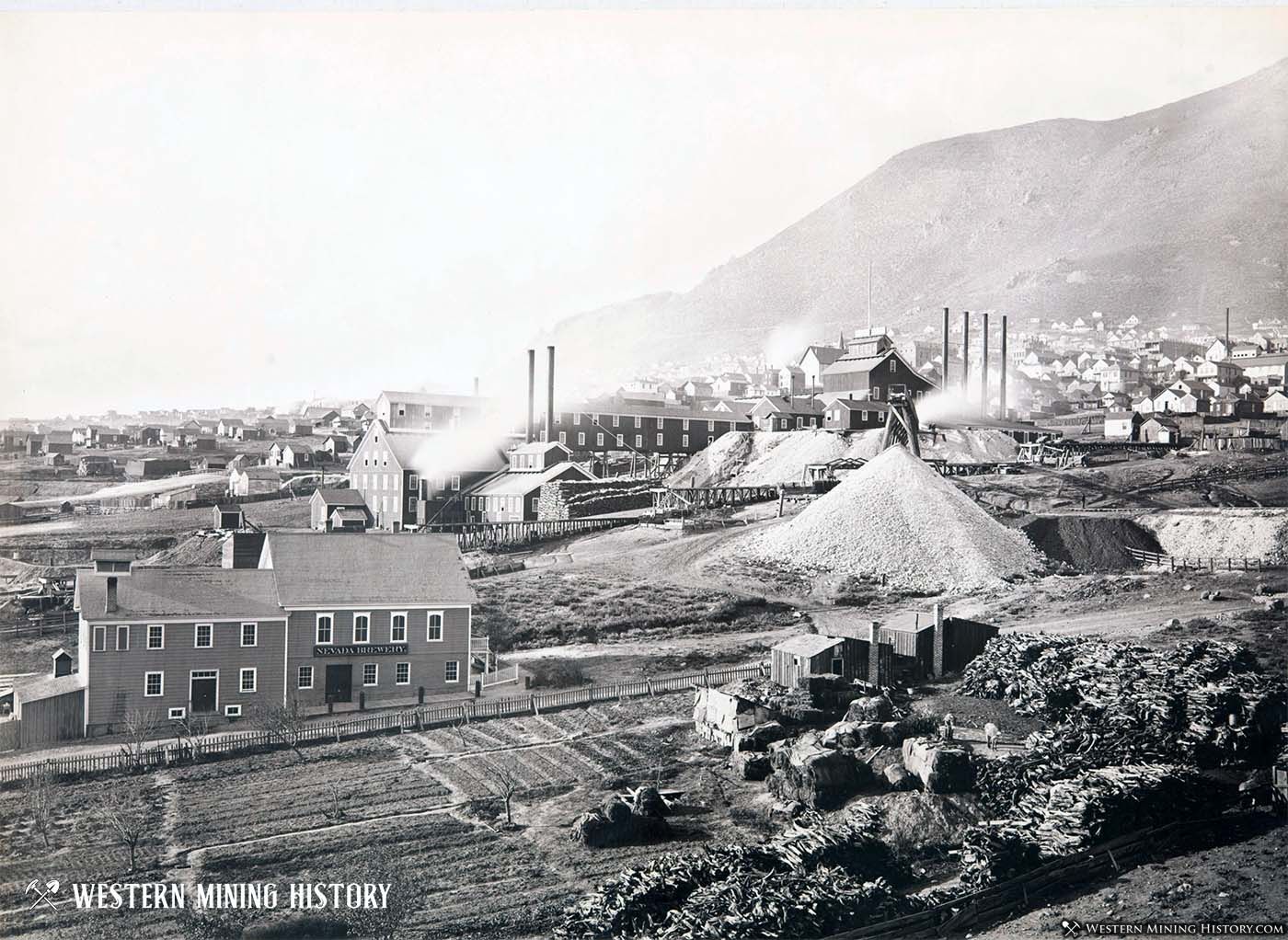
Towns and Cities
While many communities were established among the mines and mills of the Comstock Lode, the three most significant cities were Virginia City, Gold Hill, and Silver City.
Virginia City
Of the primary towns, Virginia City was the largest and most important. While estimates vary, the city had at least 25,000 residents in the mid 1870s, and that number was likely much higher.
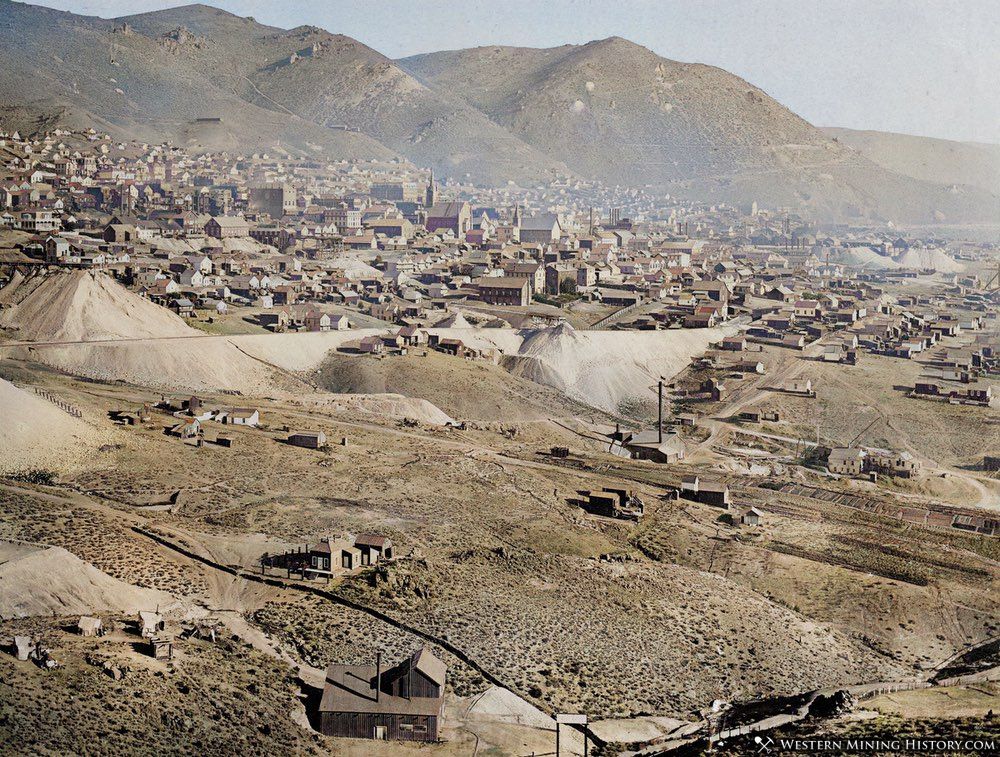
The 1883 publication Comstock Mining and Miners by Eliot Lord describes the excitement, and to a degree the hysteria, that people in Virginia City Experienced starting in the 1860s:
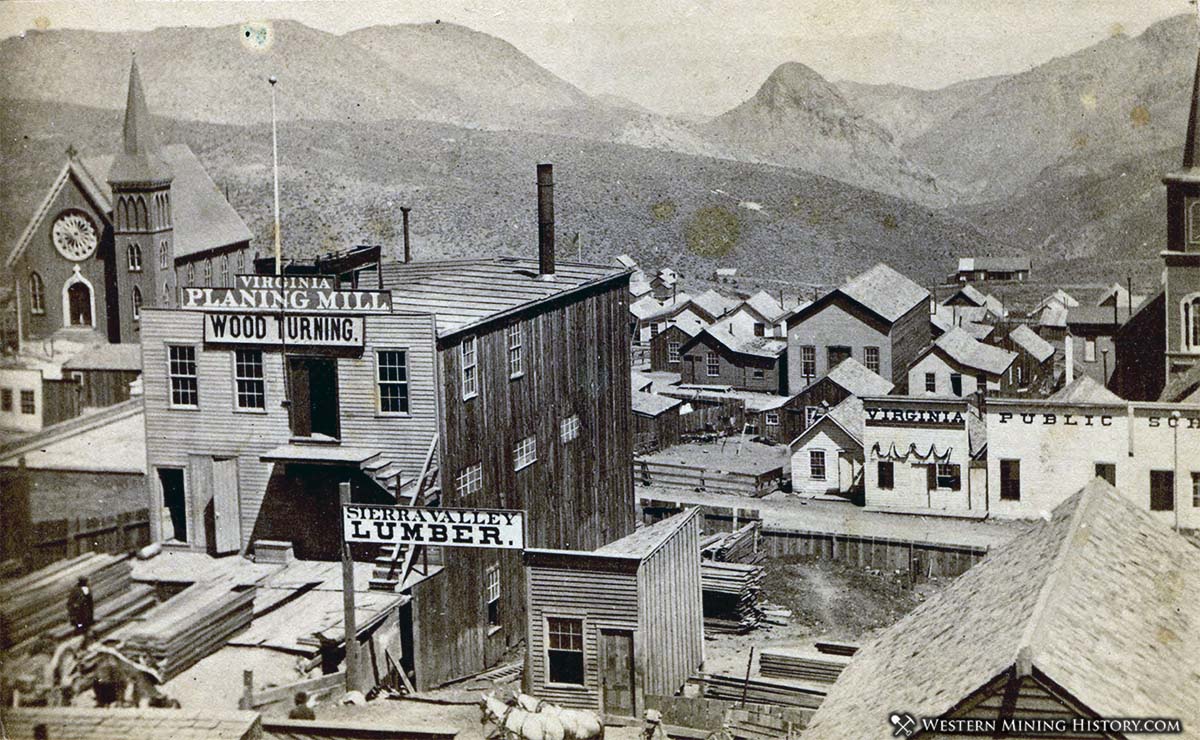
Men walked the streets of Virginia City as if pacing the roof of a fathomless treasure house, and their heads were constantly in the clouds. They saw a network of silver beneath their feet and the fine strands widening into solid wedges of ore. The eyes of the soberest minded even were dazzled by the vision, and the fancy of the imaginative ran wild. No metaphor can exaggerate the prevailing delirium.
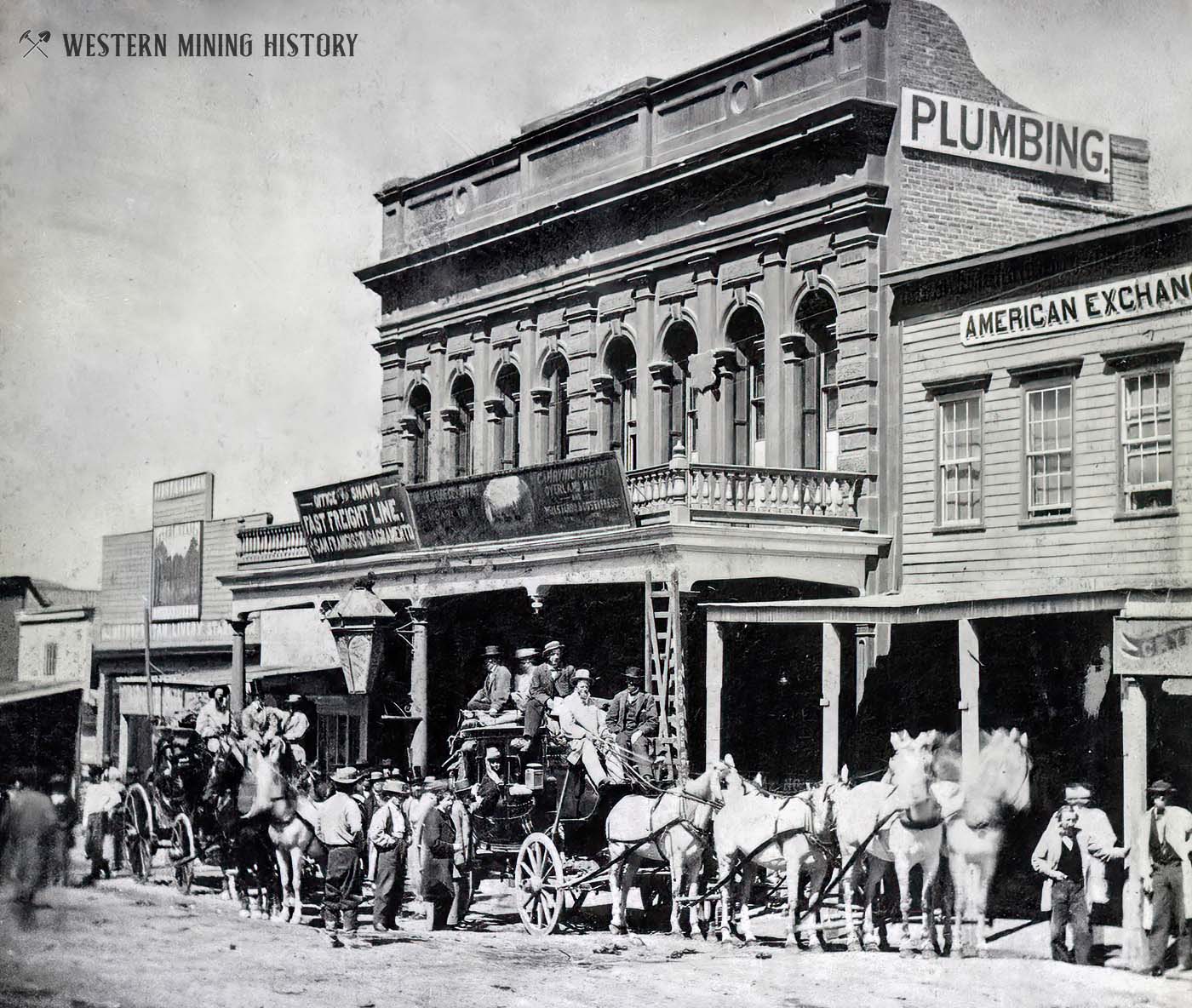
It would appear that a silver mist enveloped the slopes of the Sun Peak and men moved and breathed in its unnatural atmosphere. Drunk with the vapor, all prudent considerations were laughed to scorn. Timid suggestions of the utility of thrift and the possibility of an approaching exhaustion of the ore deposits were unheeded or unheard. Every large stockholder in a productive mine counted himself a nabob and scattered his money broadcast like a prince bestowing largesses.
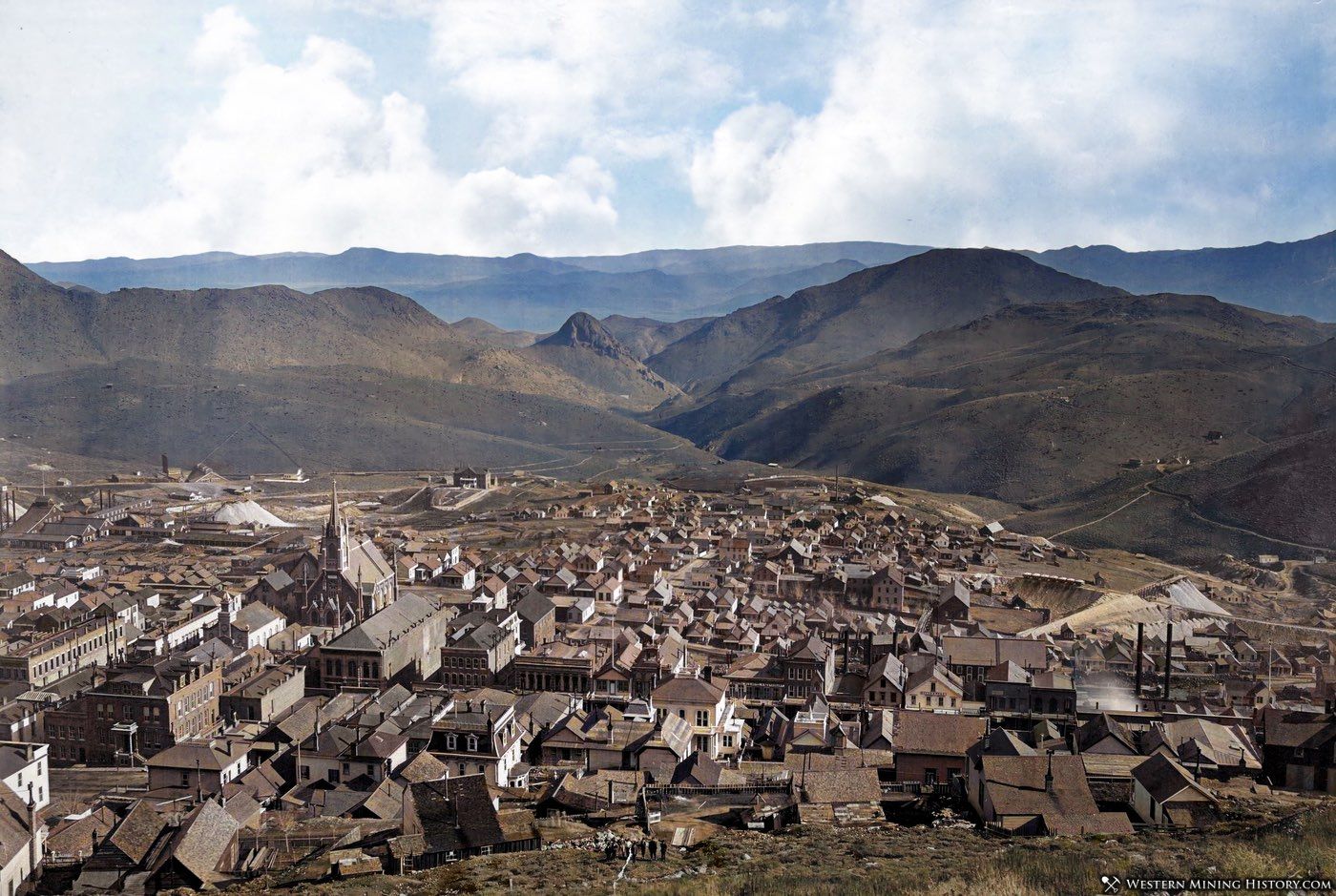
The conception of the Brazilian spendthrift in Der Seekadet is scarcely a burlesque of the Washoe production. One fits his doors with handles of solid silver and buys a library like a ledge, by the foot; another fills his water-tank with champagne to enliven the guests at a wedding.
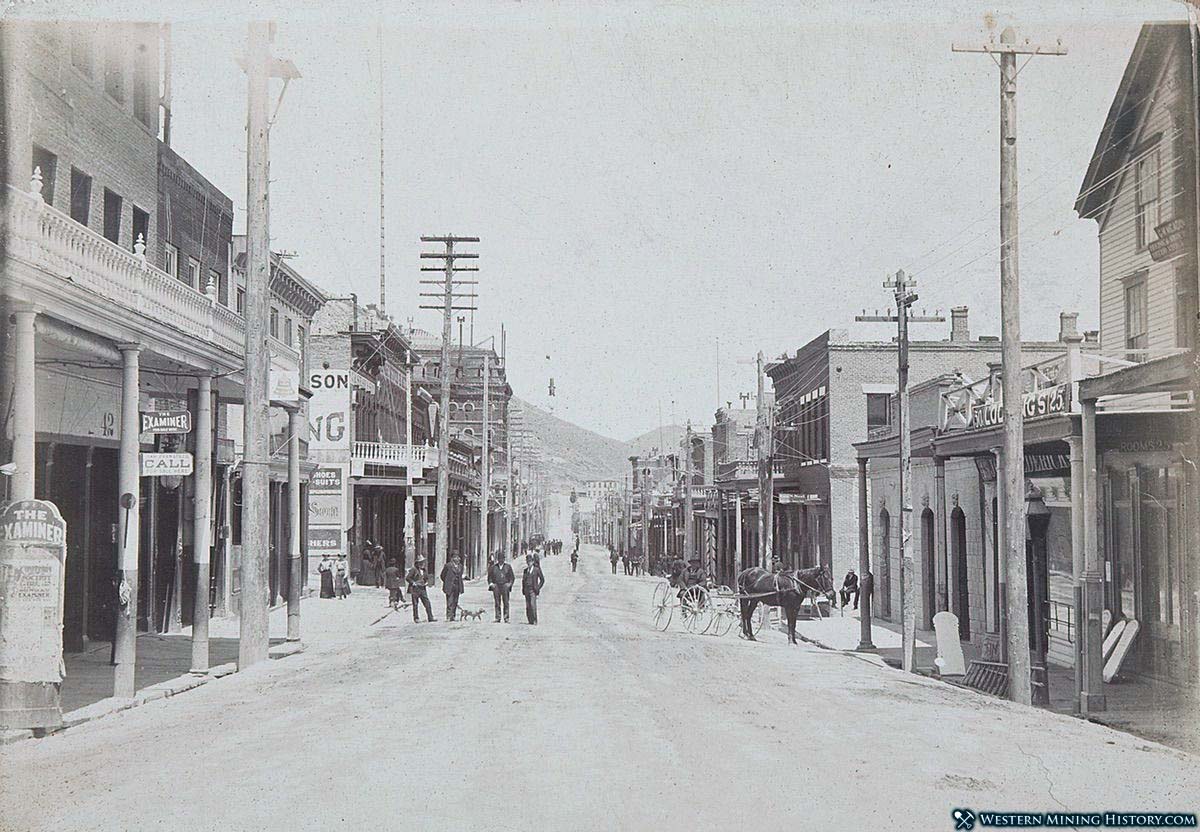
The Comstock Lode was home to over 200 ore mills, many of them in Virginia City as seen in the following image of the California pan mill.
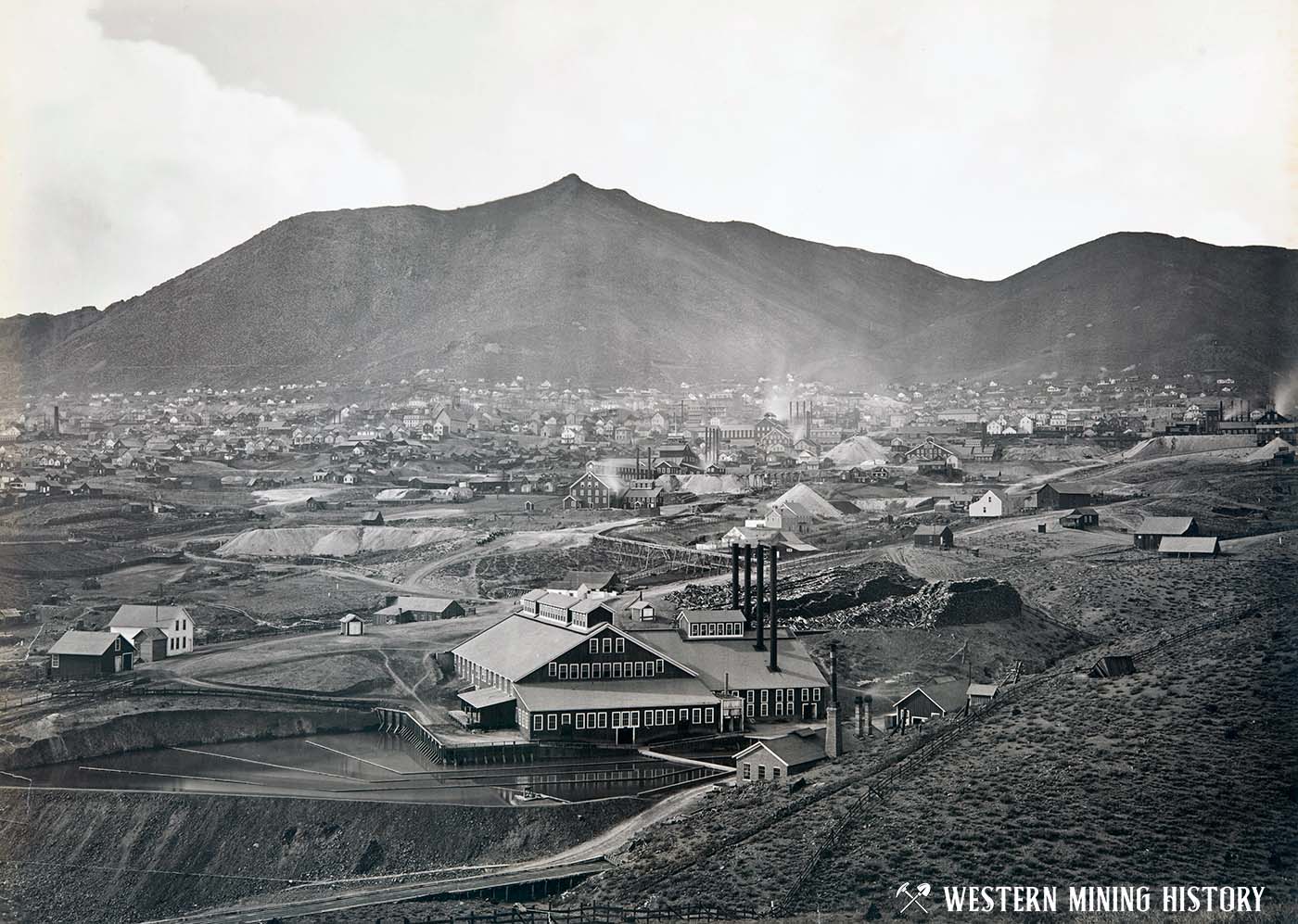
The image below is only identified as a “Newly cast bull gear for a large hoist leaving the Fulton Foundry”, but it is likely this is the same gear that was reported being cast in 1879, “weighing 40,000 pounds. It is for the Belcher-Crown Point air shaft, and will be the largest casting ever made in the state.”
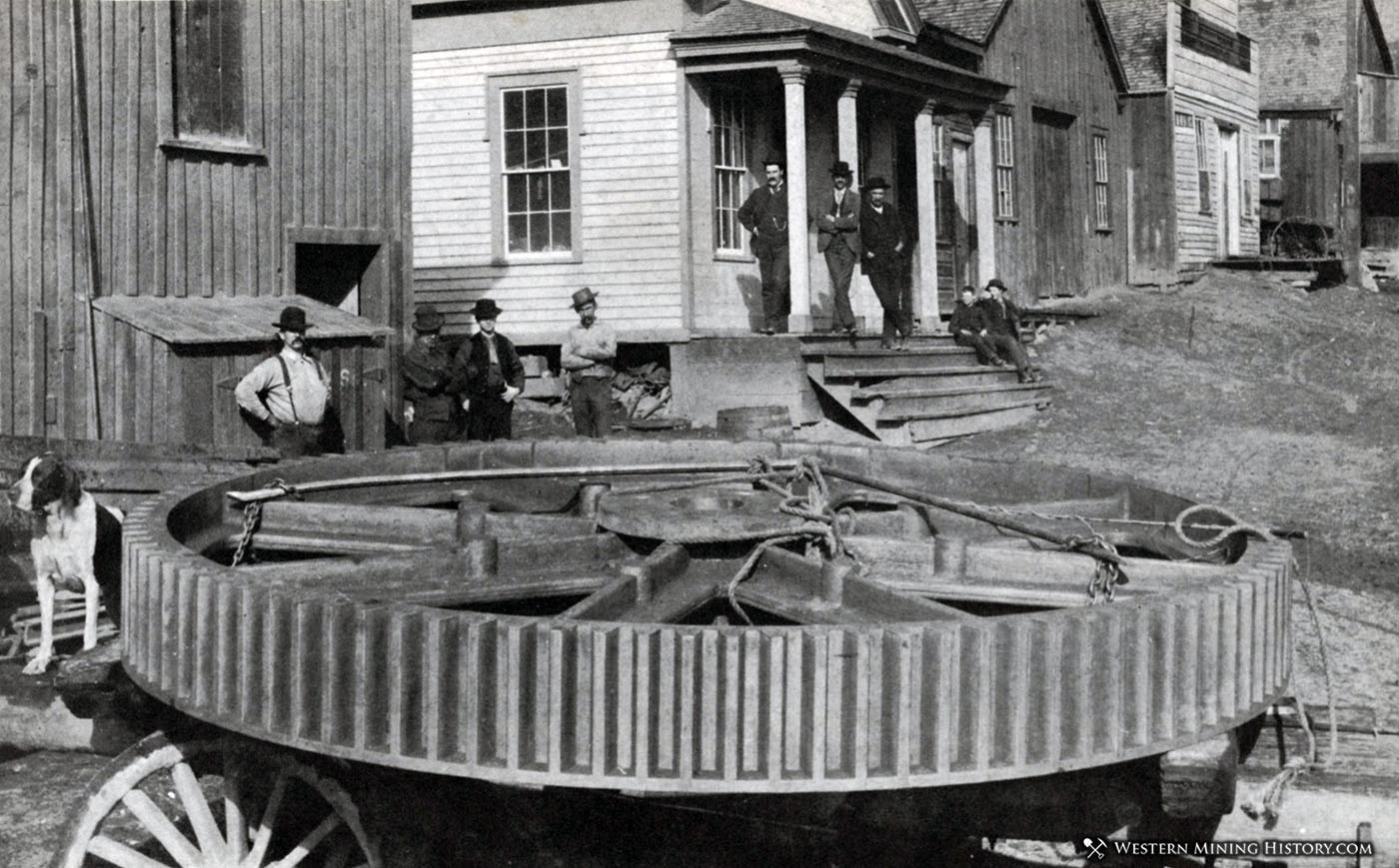
Gold Hill
Gold Hill was the location of the initial discovery of the southern end of the ore body that would come to be known as the Comstock Lode. This was the earliest settlement in the upper part of Gold Canyon, and in the initial years was an important mining and milling center that rivaled Virginia City in size and significance. In 1877 Gold Hill had around 8,000 residents.
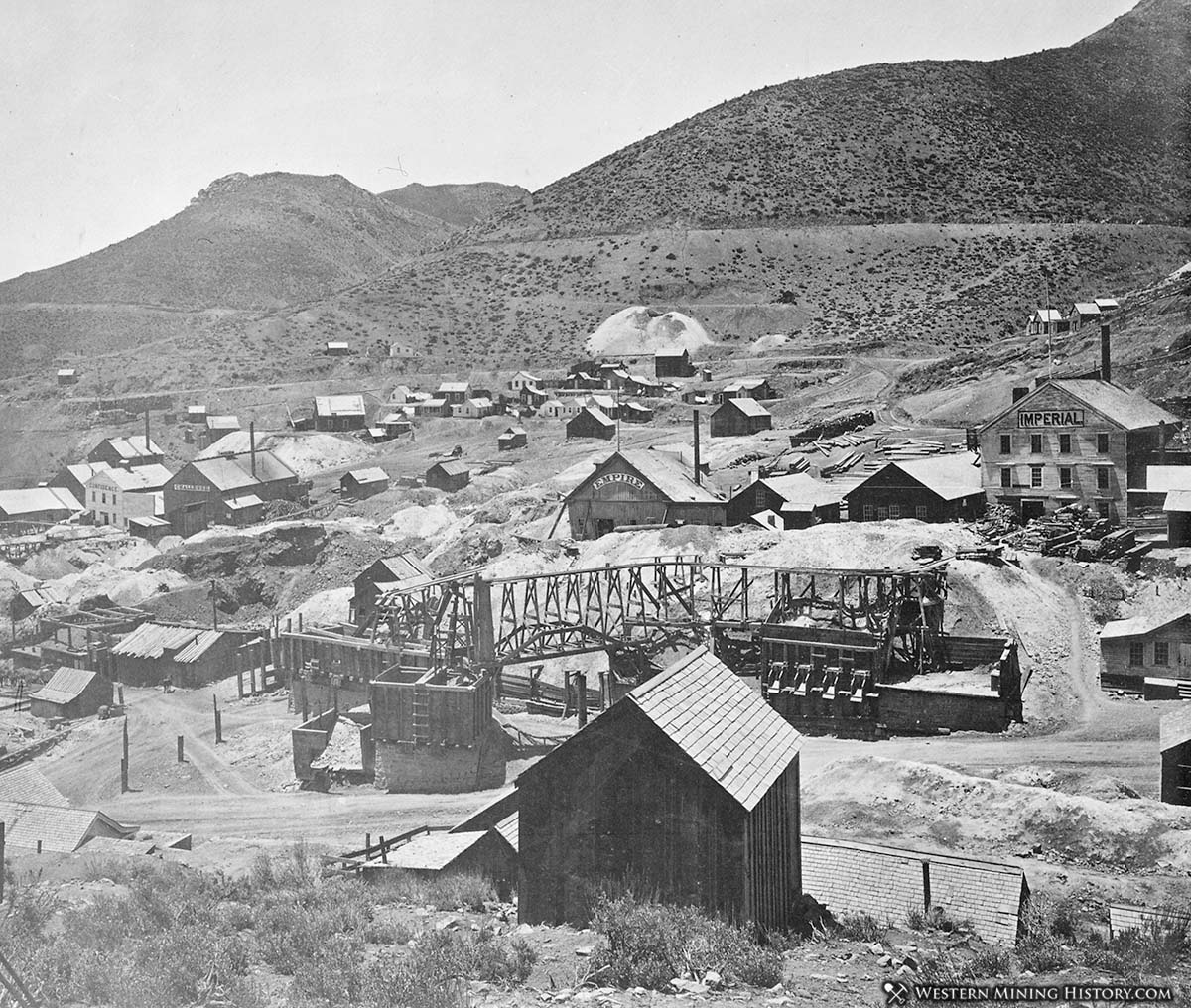
The following 1862 photo is one of the oldest images of the settlement of Gold Hill. Visible are the commercial buildings of “Cheap John”, The Wells Fargo Express Office, and the “What Cheer Hotel”.
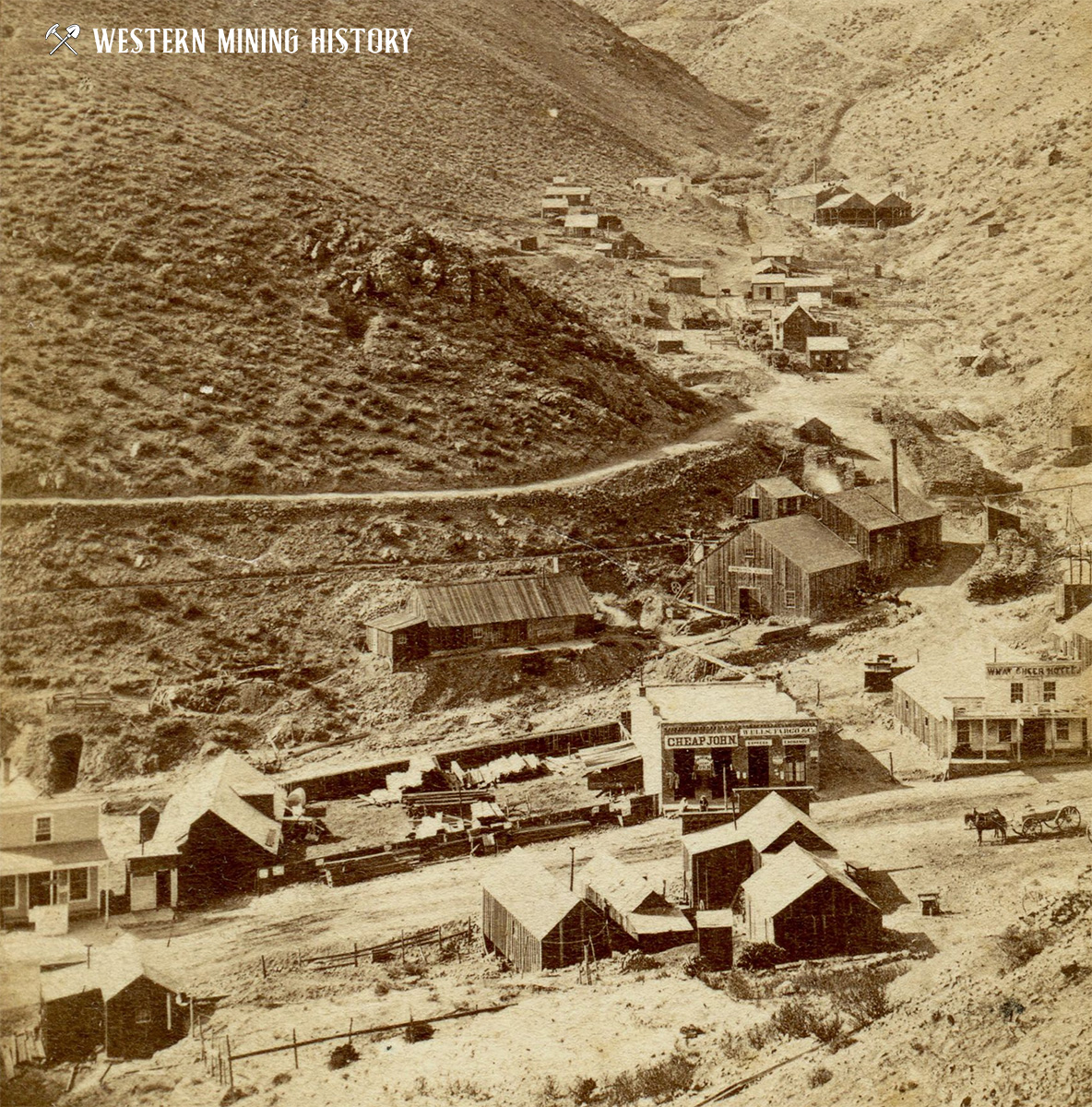
In contrast to the photo above, by 1870 Gold HIll had become a significant industrial center. It was described as being a continuous line of mines and mills from one end of town to the other.
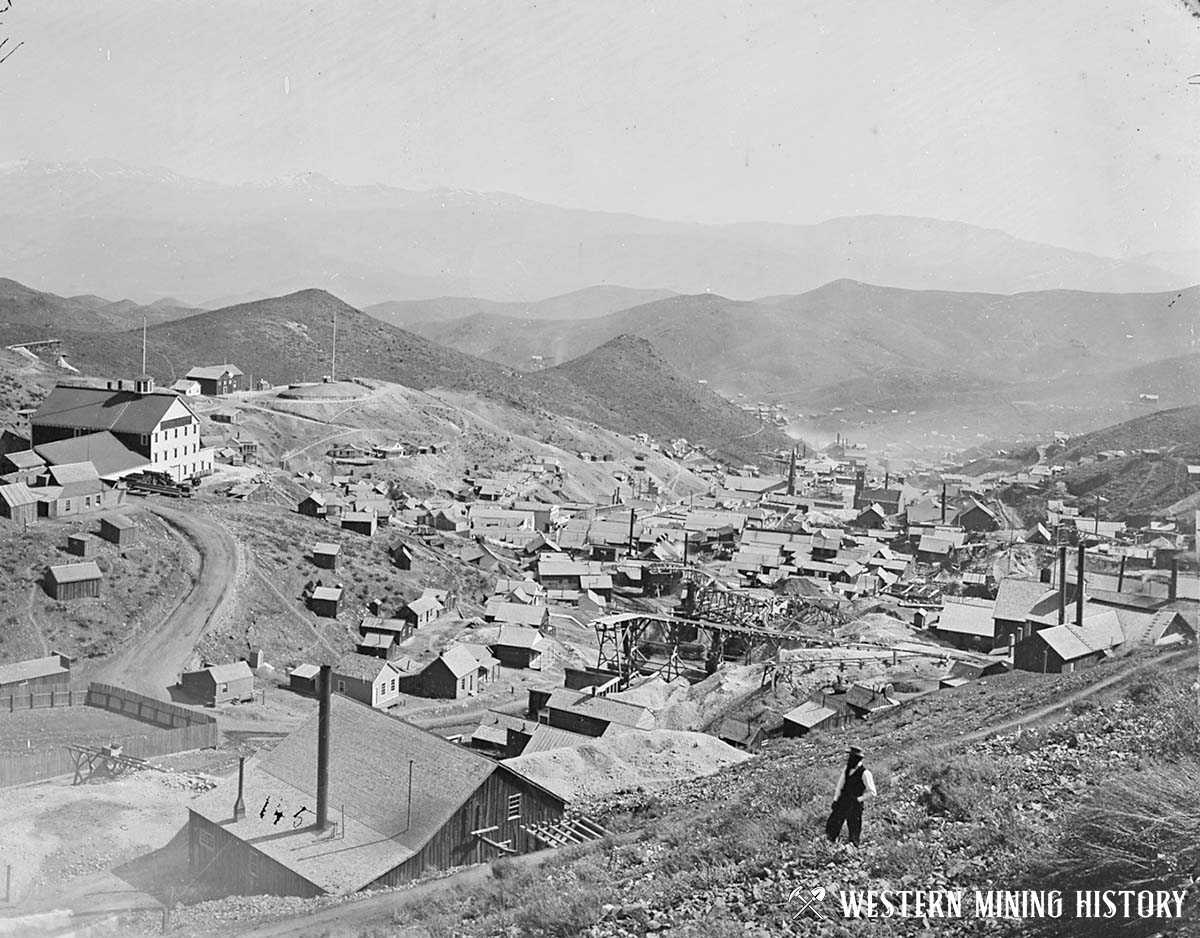
The Virginia & Truckee Railroad arrived at the Comstock Lode in 1869, greatly stimulating development of the towns and mines of the district. Pictured below is the Crown Point trestle, a famous historical landmark in Gold Hill. In the early 1900s the trestle was replace by fill and is no longer part of the V&T line.
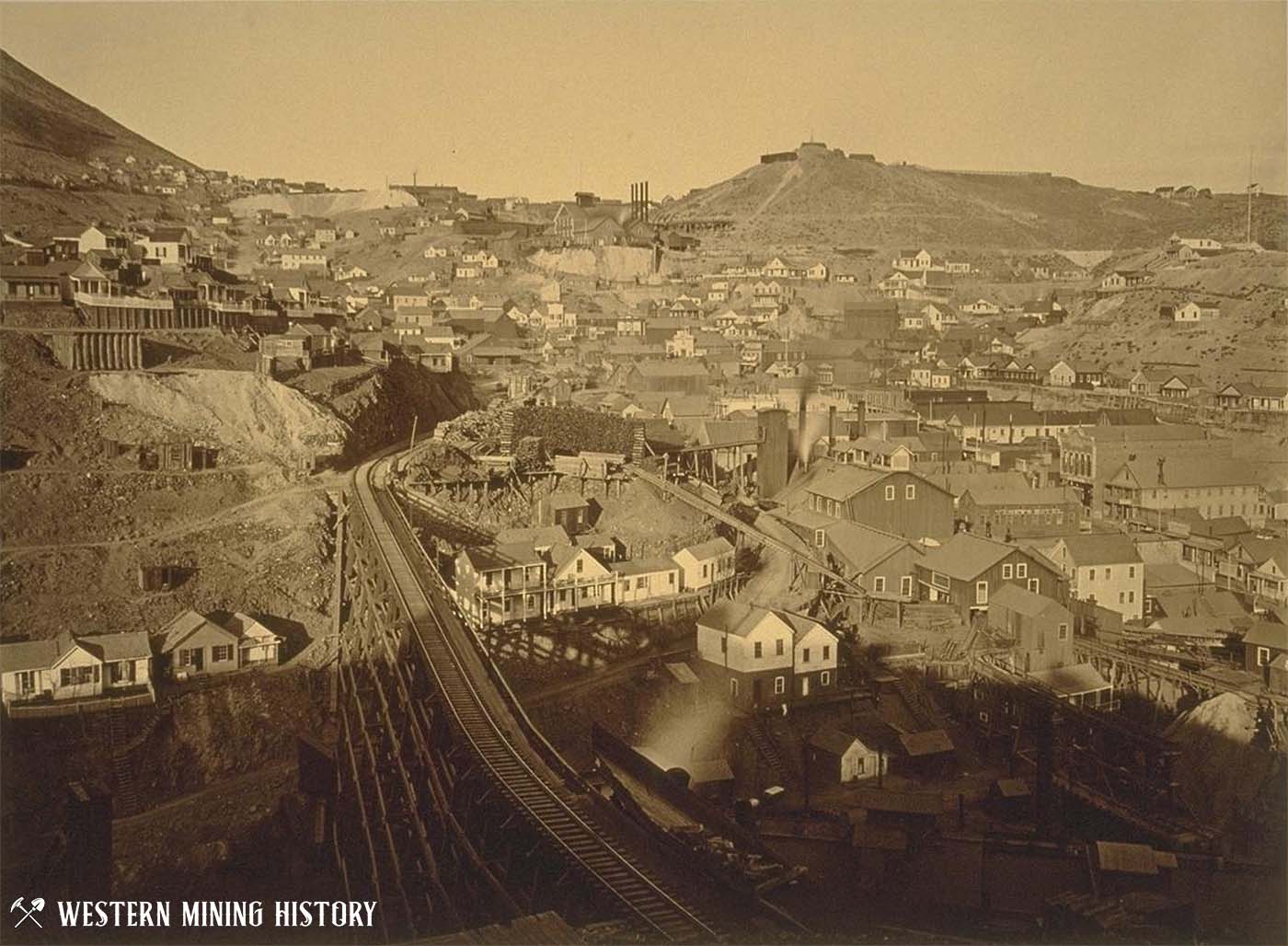
The Pioneer Steam Laundry had its operations north of Virginia City (which was north of Gold Hill). It furnished housing for several dozen workers – half Chinese Americans and others drawing from elsewhere in North America and Europe. The Pioneer was different from the neighborhood laundry shops – typically operated by teams of Chinese or single Irish widows. The Pioneer mainly handled commercial accounts, cleaning laundry in bulk for hotels and other businesses and using a steam process; laundry deliveries were available throughout Gold Hill and Virginia City.
Source for the above text: Ronald M. James, Richard D. Adkins, and Rachel J. Hartigan, “Competition and Coexistence in the Wash House: A View of the Comstock from the Bottom of the Laundry Pile,” Western Historical Quarterly 25:2.
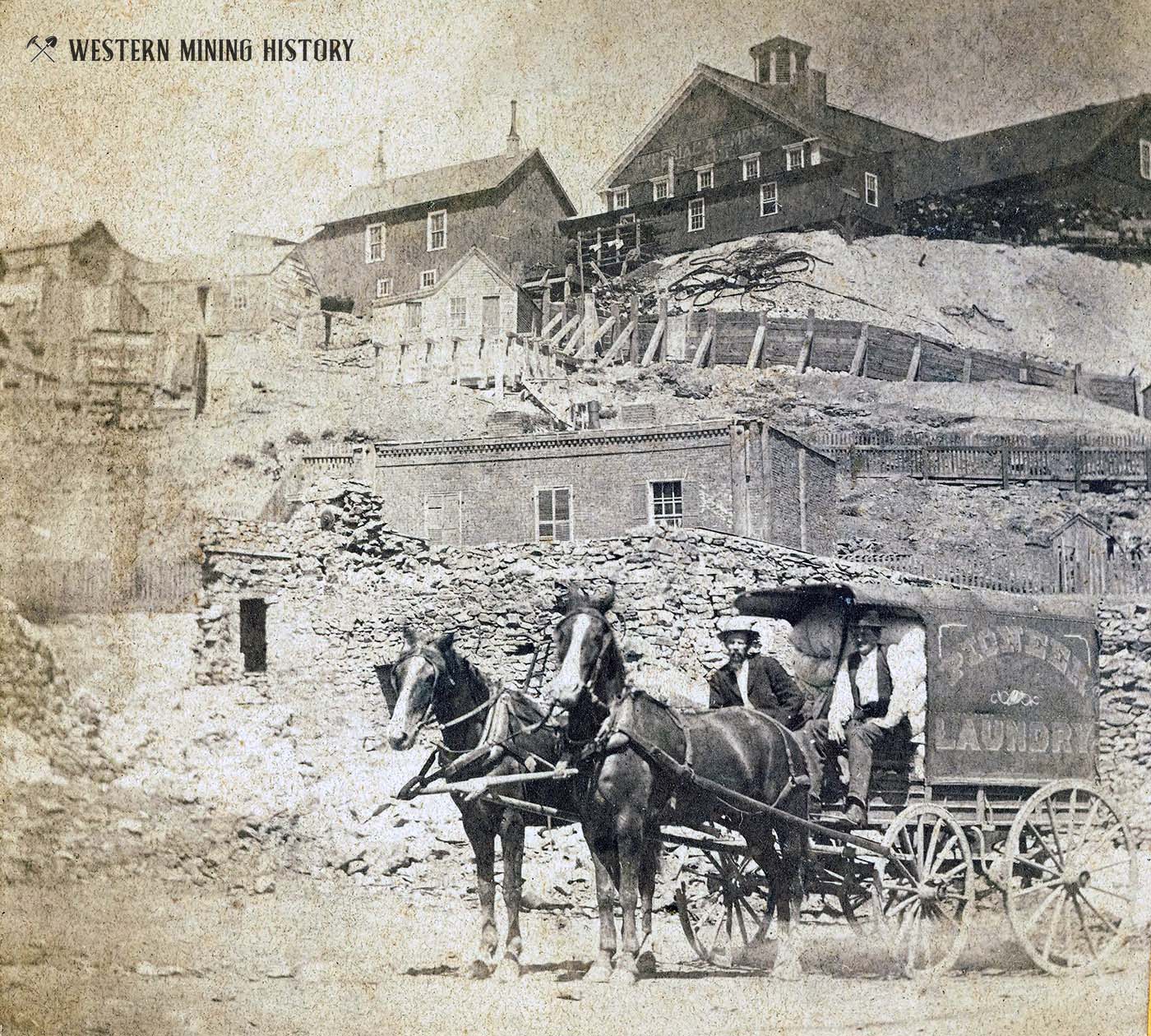
This final view from high above Gold Hill shows the layout of the town and the significant mining activity of the area.
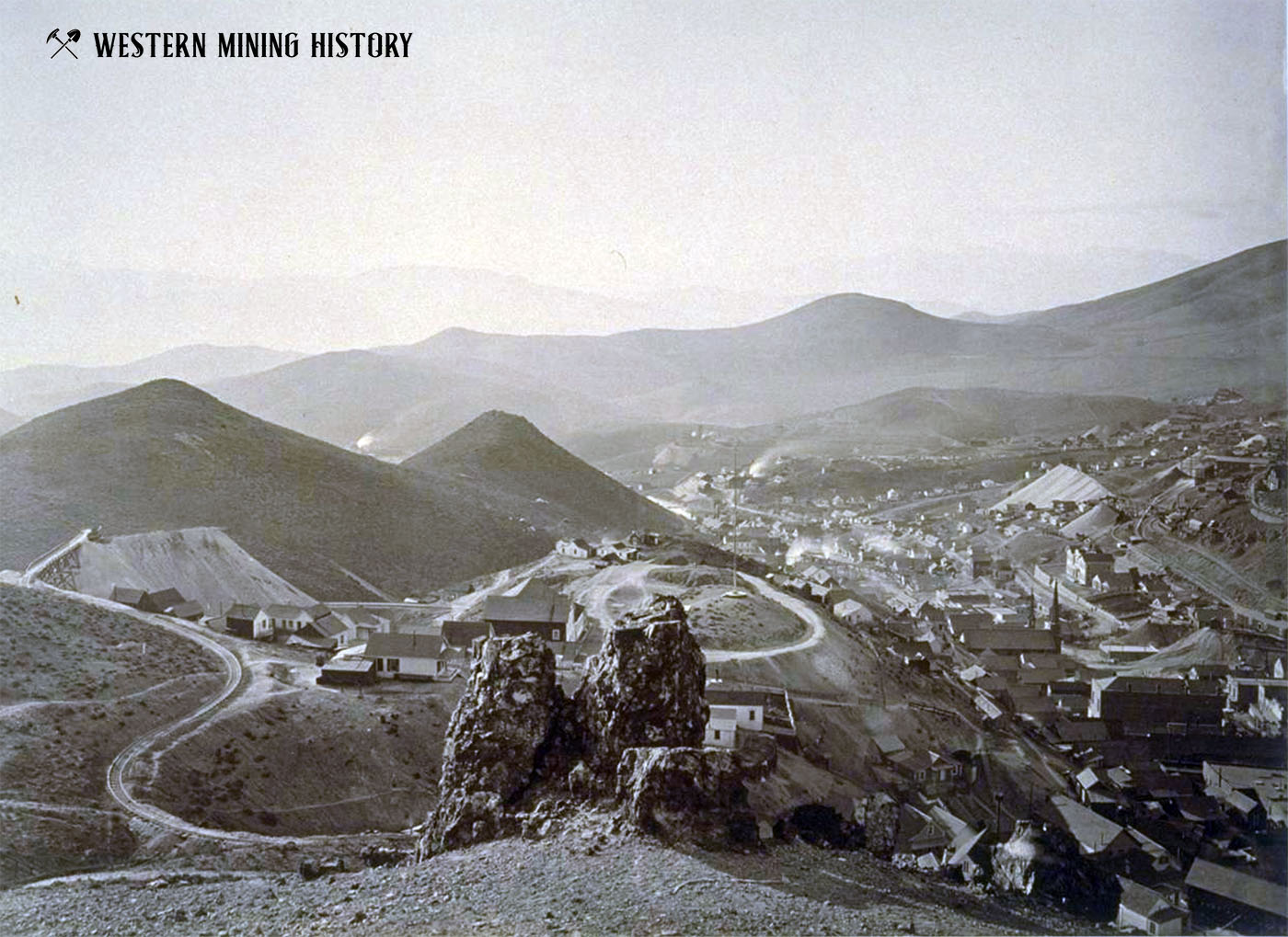
Silver City
Silver City was settled in 1859, and is one of Nevada’s oldest towns. It became an important milling center in the 1860s for Comstock ores. Prior to the arrival of the railroad in 1869, the town was an important transportation center for wagon traffic up and down Gold Canyon, and was the primary boarding location for stock animals that pulled the hundreds ore wagons that transported ore from the mines to the various milling centers of the area.
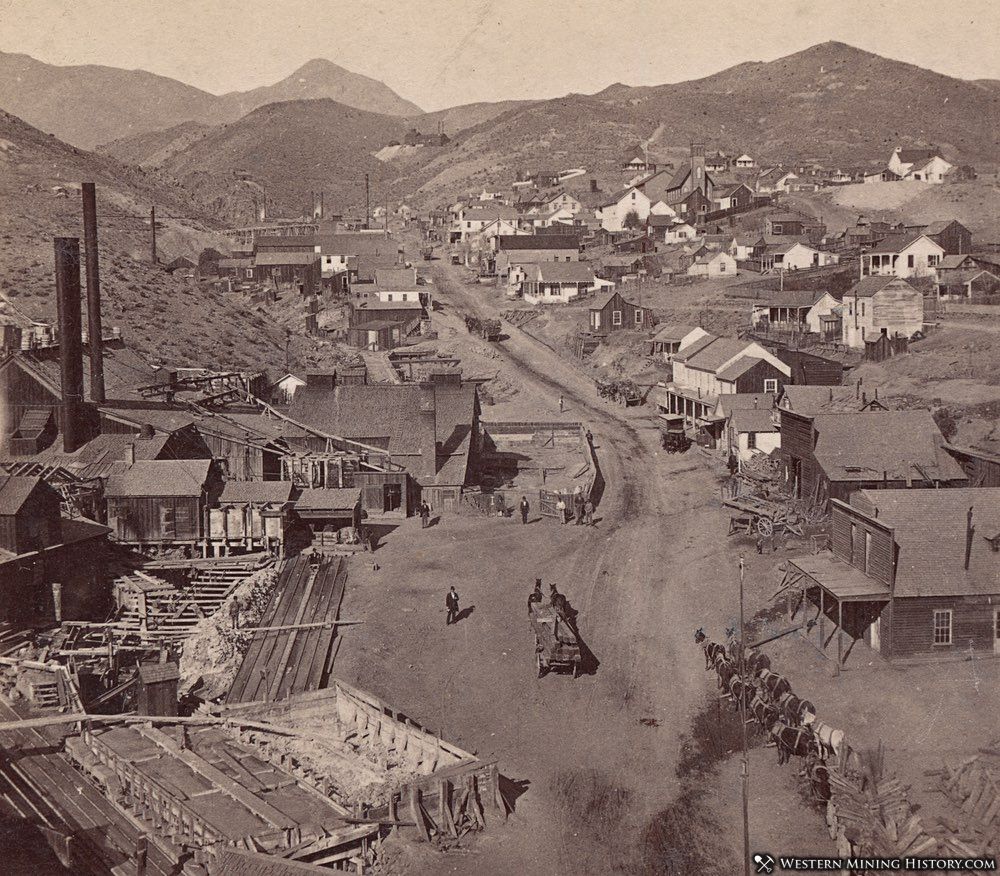
Devil’s Gate is a famous landmark just north of Silver City. In the late 1850s and early 1860s it was known as a location where highwaymen and robbers would stalk their prey. The narrow passage later became a toll gate on the most important road to the Comstock mines.
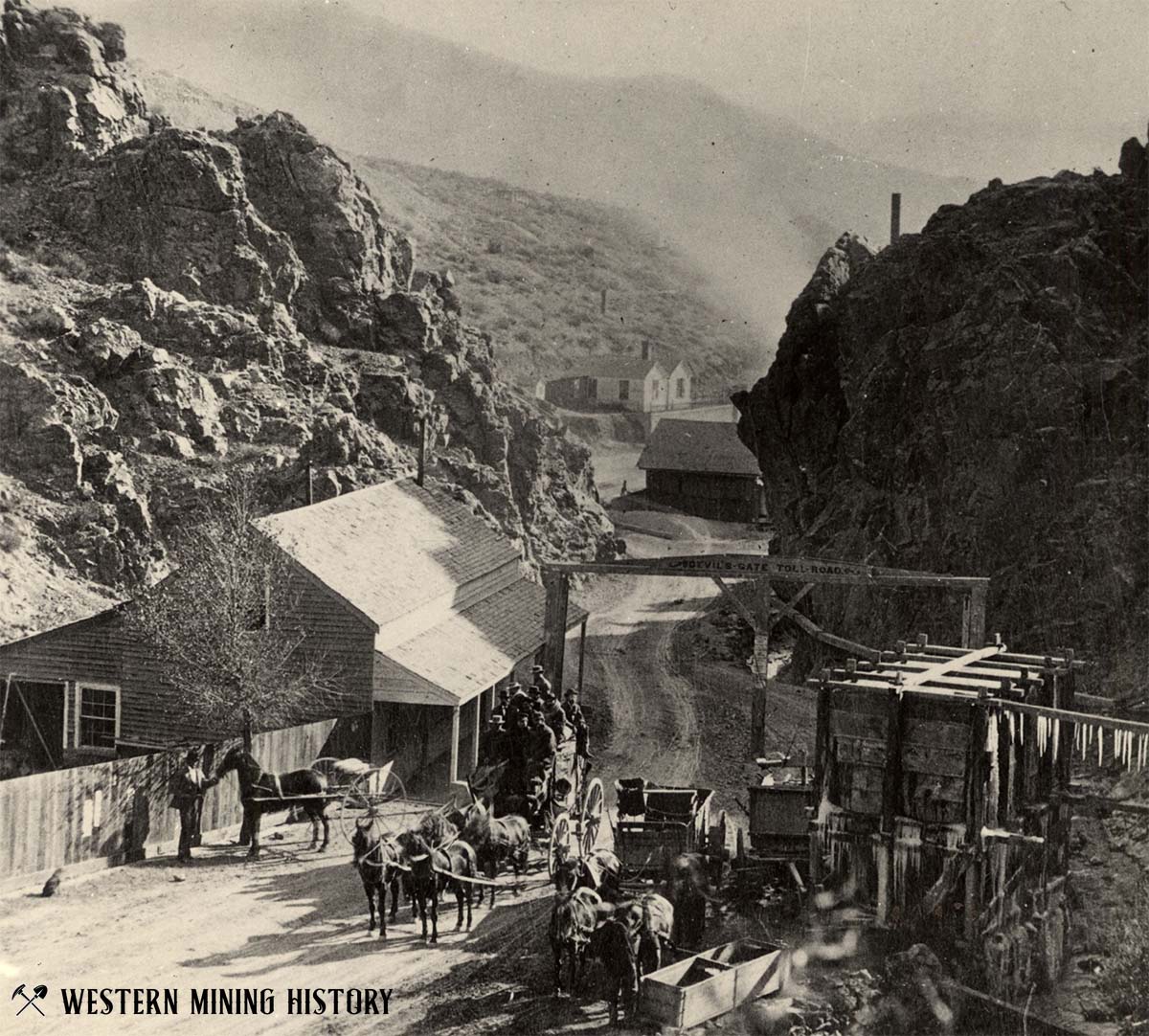
Silver City faded in the 1870s as the railroad significantly reduced it’s importance as a transportation center. The town persevered however, and is still active today with a small population.
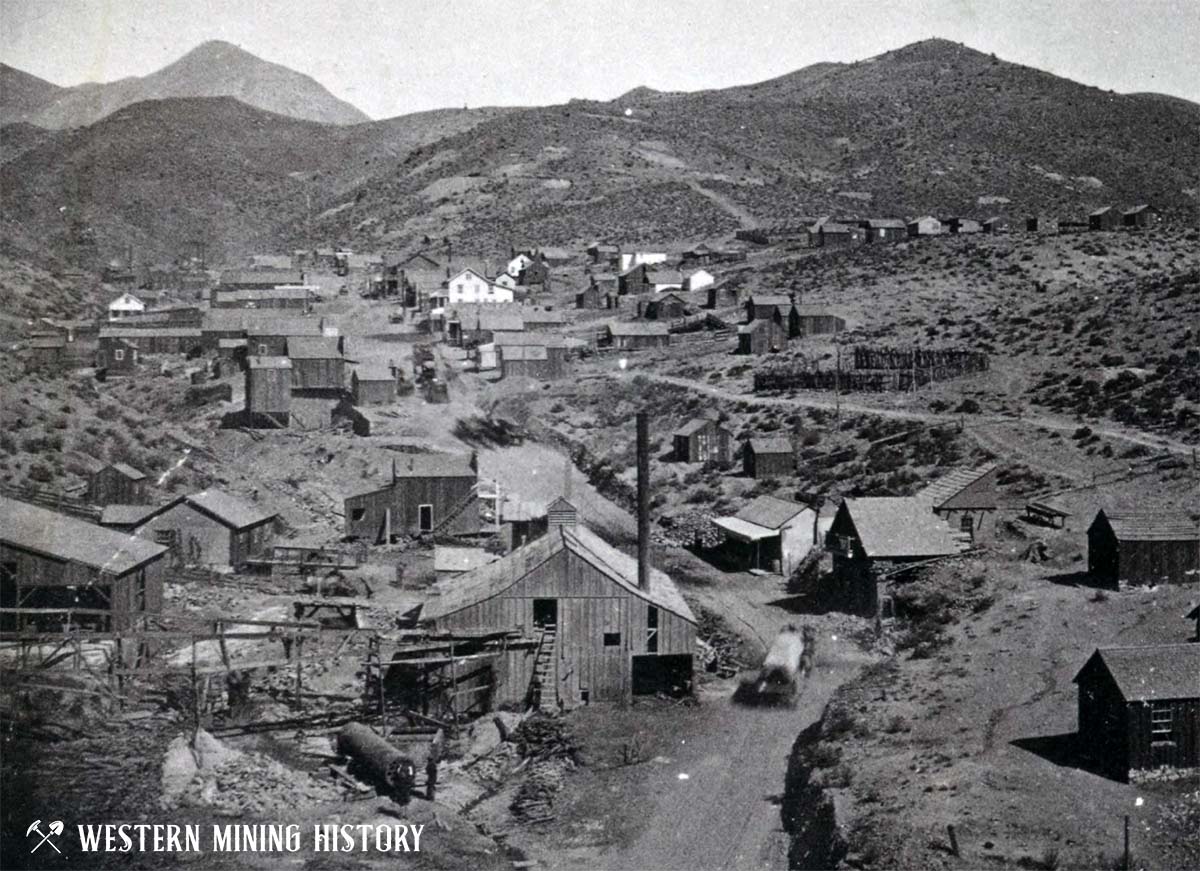
The Mines of the Comstock Lode
The mines of the Comstock Lode were the West’s first great underground mines. These vast deposits of mineral wealth required incredible feats of engineering to extract. The techniques and equipment developed here revolutionized mining throughout the world. These are just a few of the “Bonanza” mines of the Comstock.
Union Consolidated Mine
The Union Consolidated shaft was located in the Sevenmile Canyon area. The three-compartment shaft was a joint-effort between the Ophir, Mexican, Union, and Sierra Nevada mines.
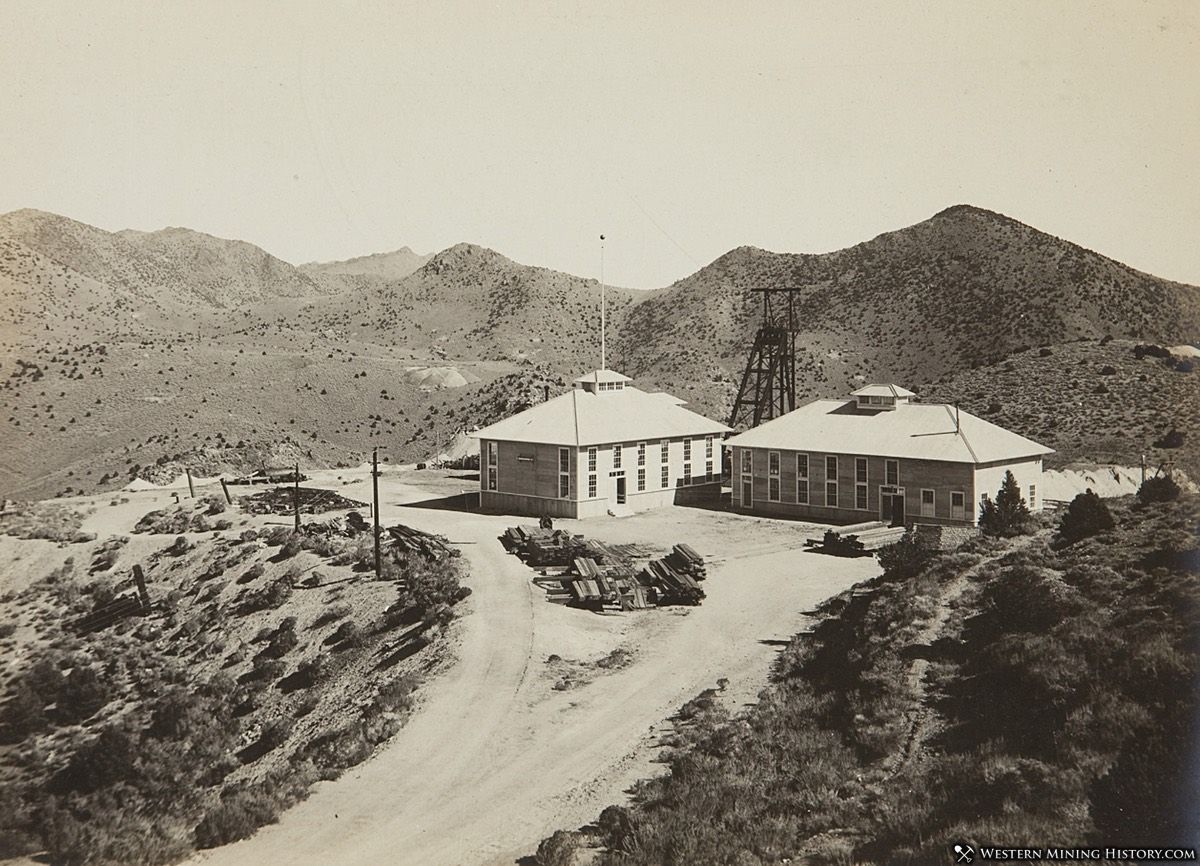
The photo above depicts a seemingly ordinary mining operation, but this was Sevenmile Canyon’s largest producer, and home to one of the most extraordinary pieces of equipment ever installed in a western mine.
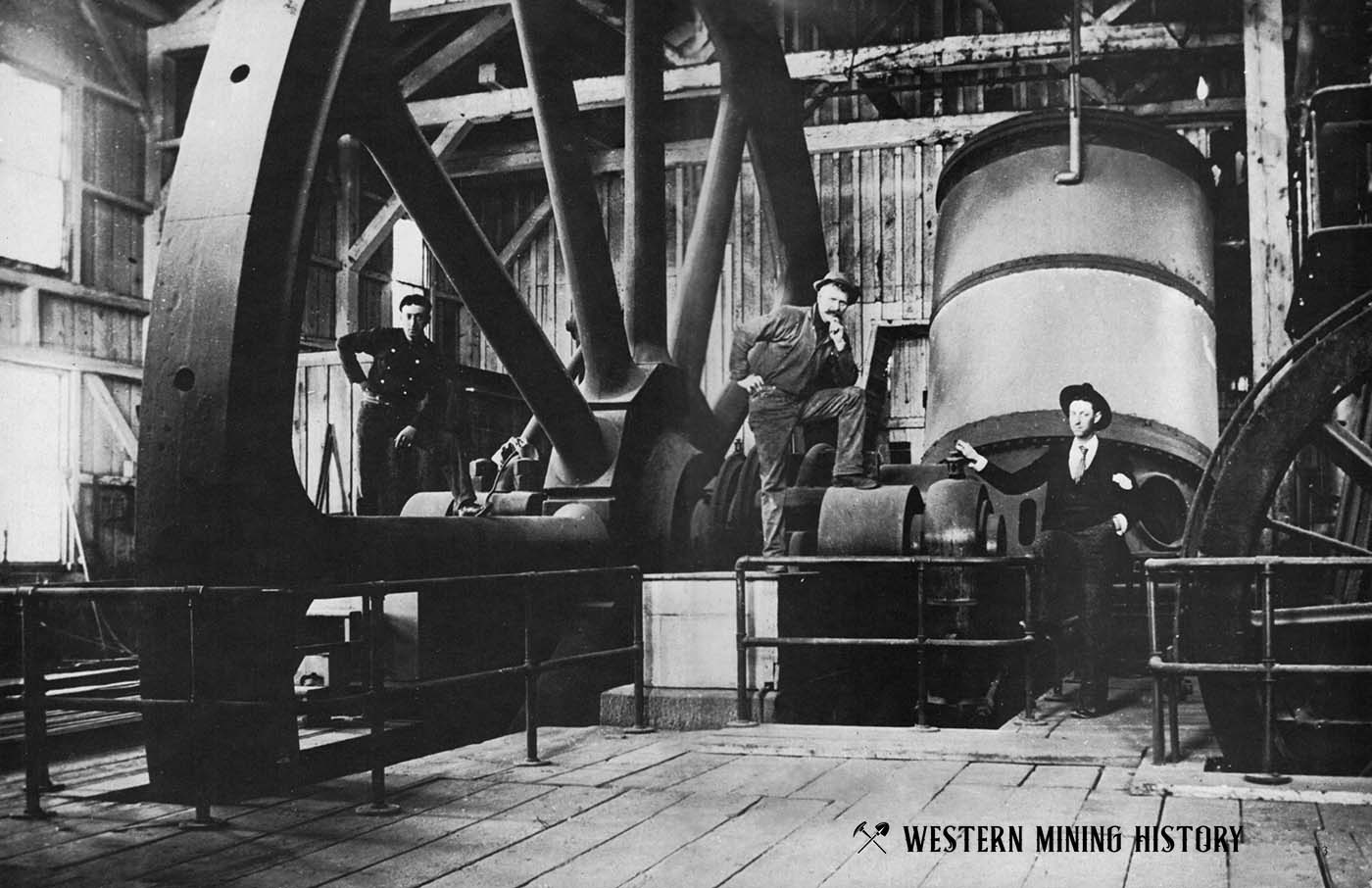
The mines of the Comstock Lode of Nevada were incredibly rich, but as they got deeper, both water and heat posed great difficulties that needed to be overcome. No expense was spared to drive the mines ever deeper. Pictured above is the Cornish Pump that was installed at the Union Consolidated shaft. At the time it was the largest in the world and cost an astronomical $410,000 to install.
Scientific American described the pump as having “a flywheel 36 feet in diameter, which, with its shaft alone, weighs 208,700 pounds. The high-pressure cylinder is 64 inches in diameter by 6 feet 9 inches stroke, and the low-pressure cylinder 100 inches in diameter by 8 feet 6 inches stroke.”
Utah Mine
The Union Consolidated was not the only mine that had a massive pump. The following image depicts an engineer posing on the Cornish pump of the Utah mine (located north of Virginia City).
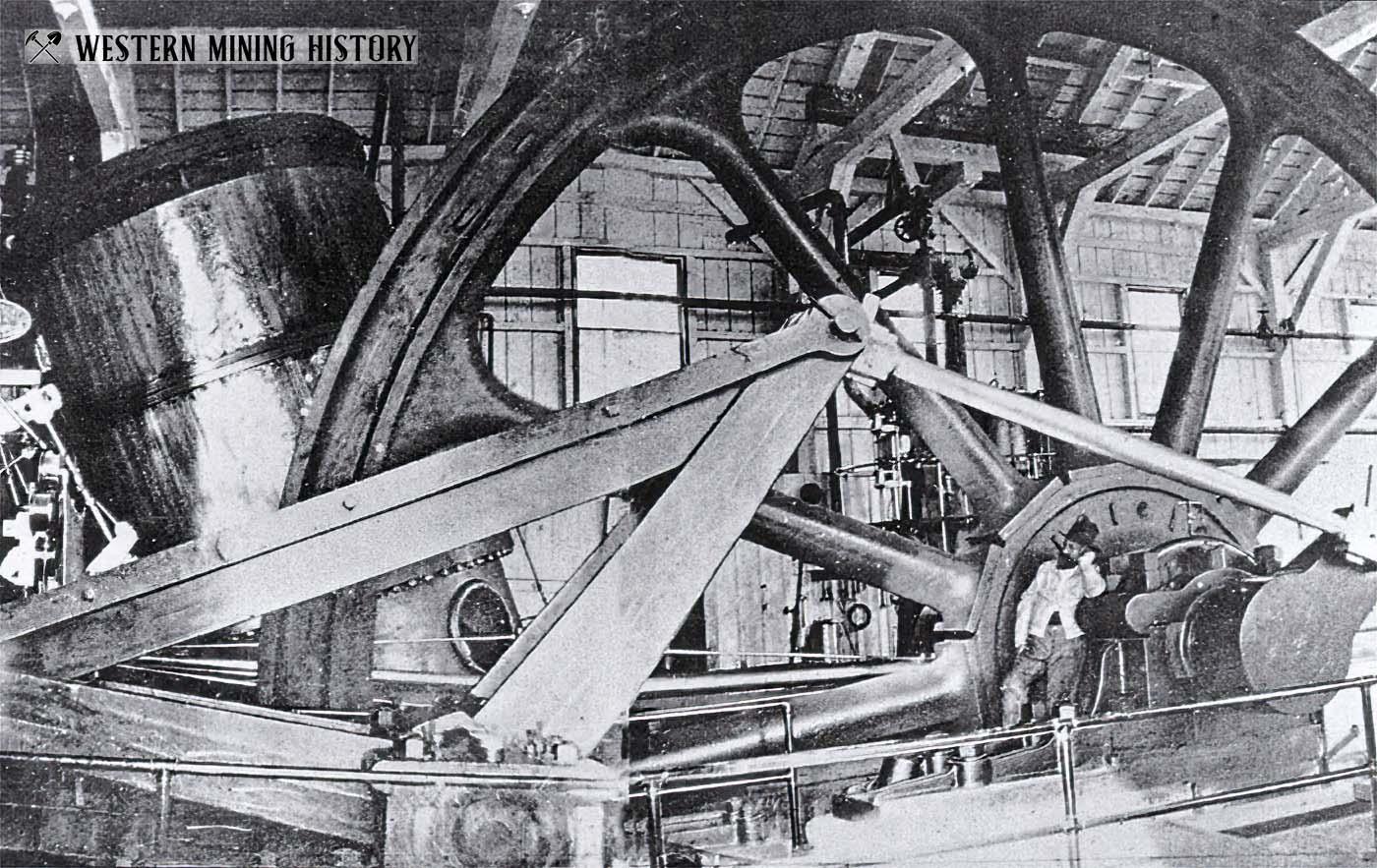
Savage Mine
The ca. 1868 image below of the Curtis Shaft of the Savage Mine is one of the most famous historical photos from the West’s great mining centers.
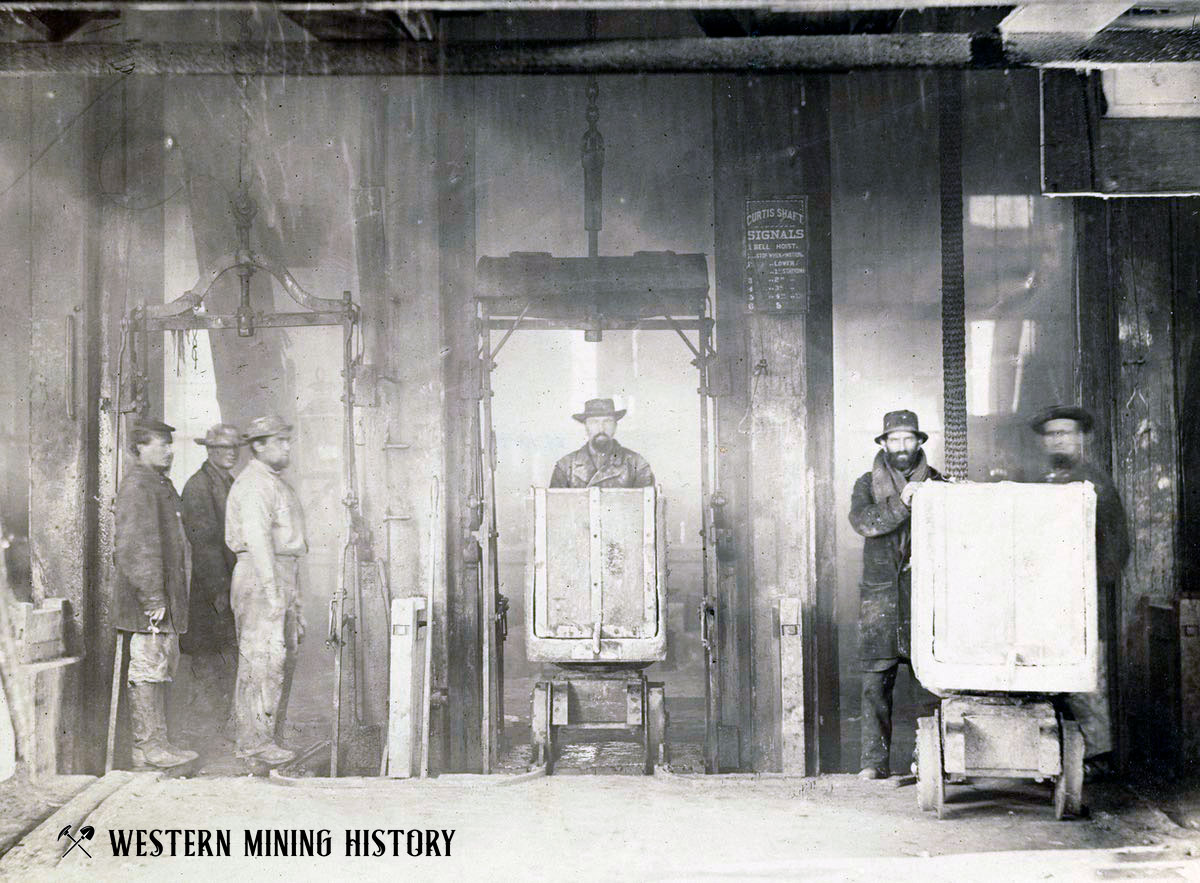
This is what the Savage Mine Hoisting Works looks like about the time the above photo was taken.
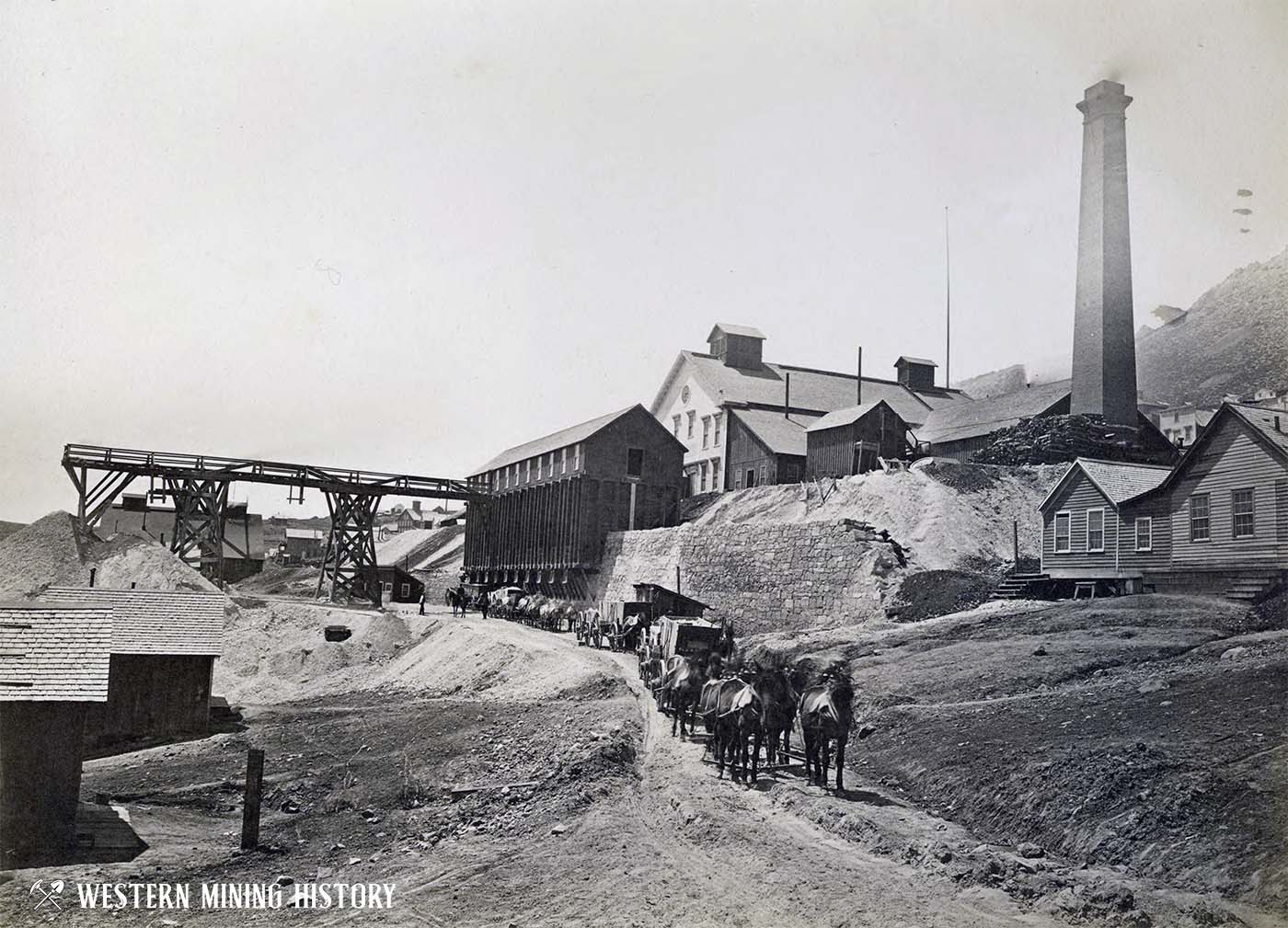
The photo below shows Virginia City during its peak years of the mid-1870s. The Savage Mine is flanked by the expanding works of the Hale and Norcross mines. As the mines became ever deeper and hoisting became a difficult and expensive operation, these three mines combined efforts to construct the Combination shaft.
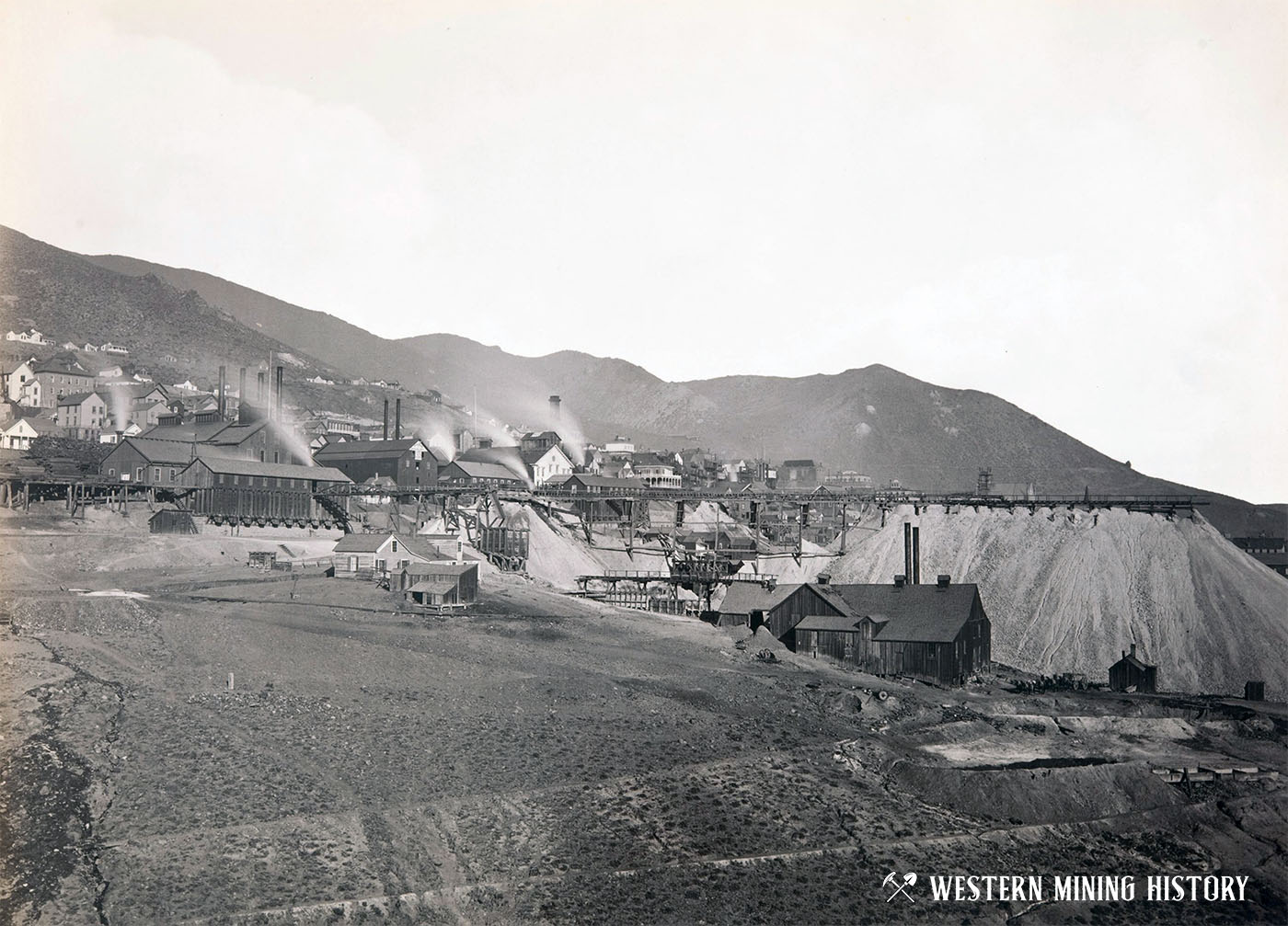
Bullion Mine
The Bullion mine is on “The Divide”, which is the high point on Gold Canyon that separates Gold Hill from Virginia City. The Bullion claim was staked in 1859 and in subsequent years the mine absorbed many neighboring claims. For over two decades this mine invested millions in exploration but never had any record of actual production.
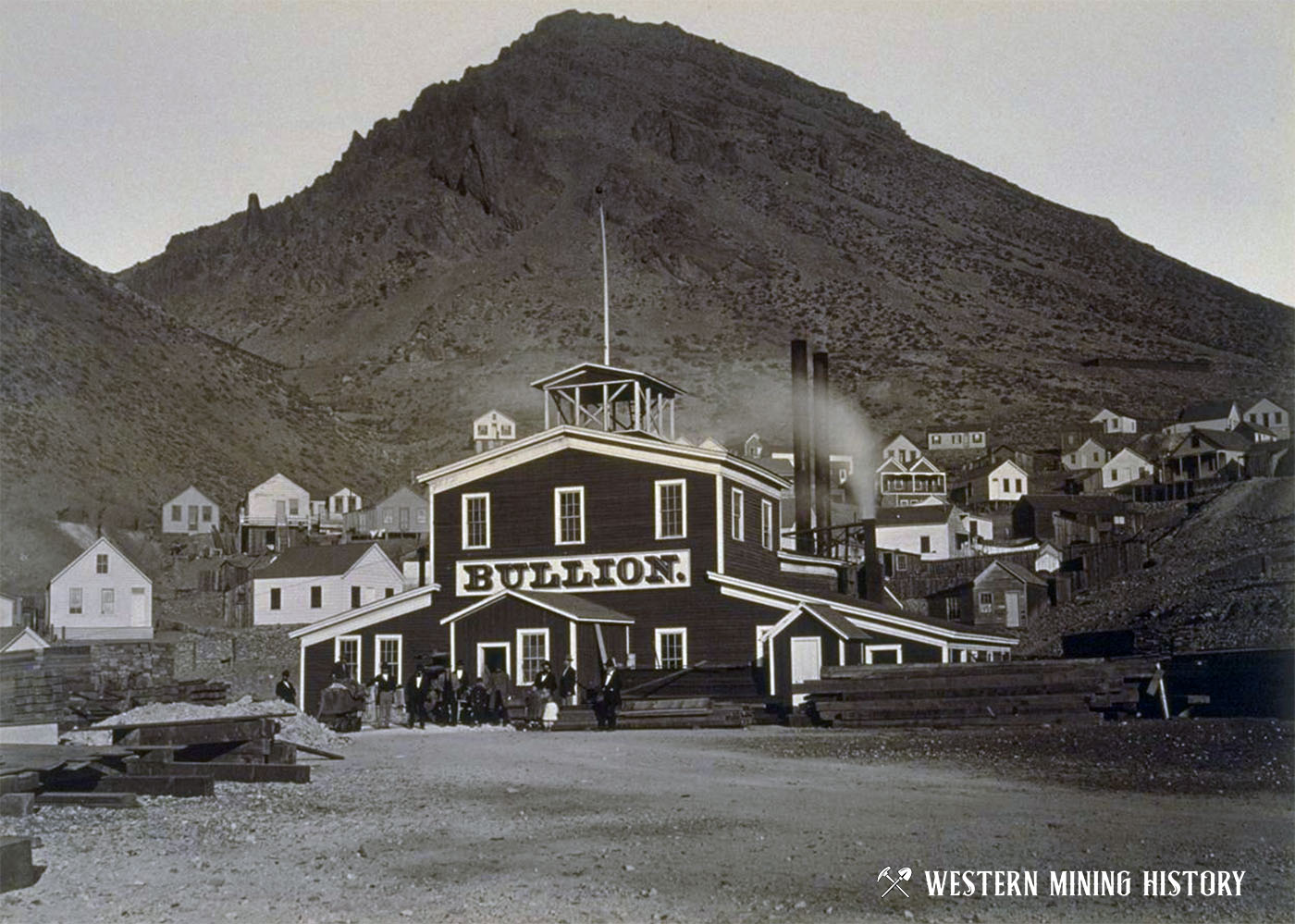
The Bullion had rich mines on to the north and south, which gave investors reason to believe there was rich ore that would inevitably be discovered if exploration continued, but a discovery was never made. Not even “Bonanza King” John Mackay, who was a trustee and became superintendent in the late 1860s, could turn the mine around.
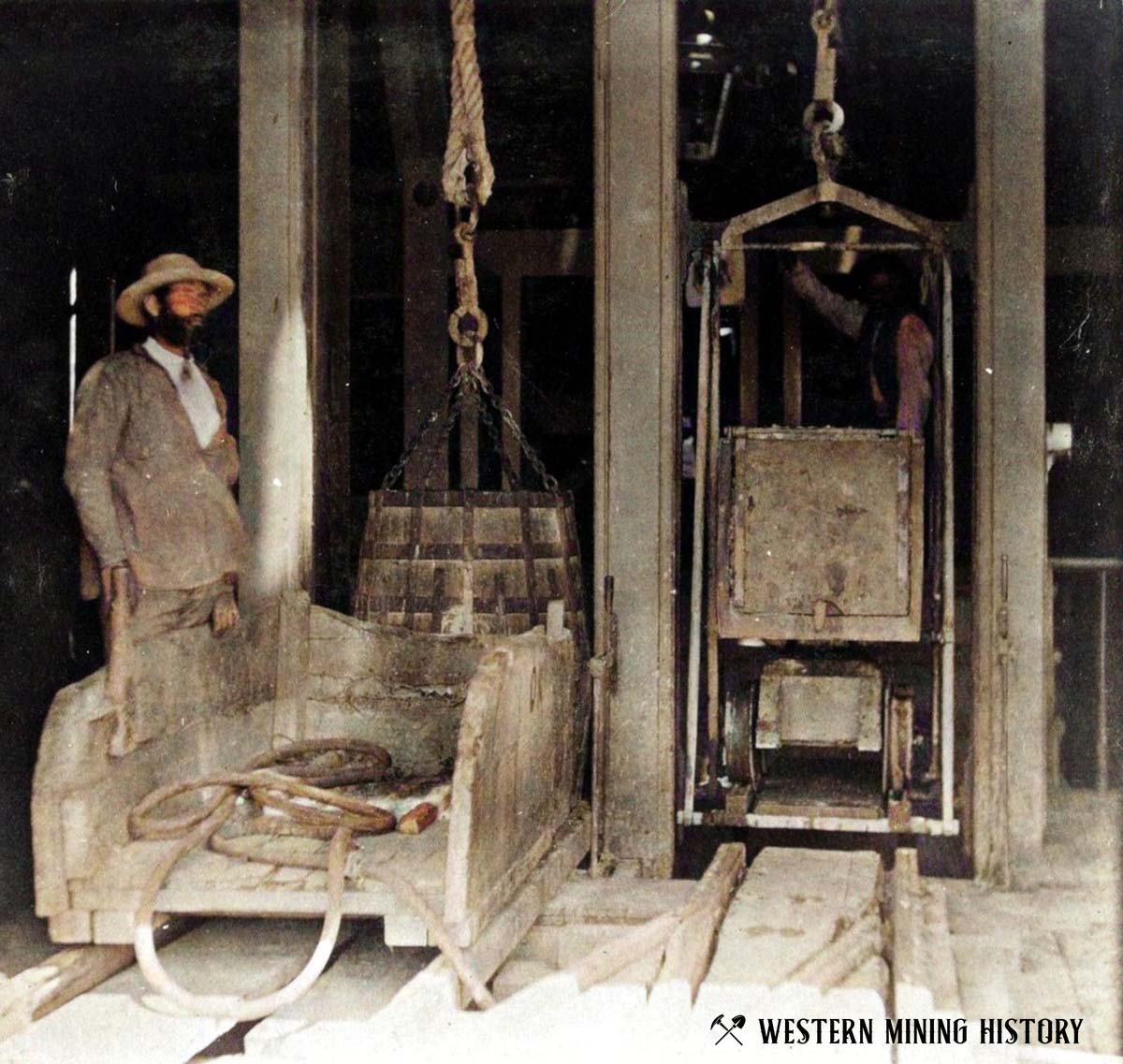
The Work Underground
The mines of the Comstock Lode were difficult and dangerous places for the miners of the 1800s. They dealt with extreme heat, hot water, falling rock, failing equipment, and fires. They worked by candlelight and without safety equipment.
Underground photography was very difficult at the time, so not many underground photos exist today. However, just like the mining industry was pioneering new methods at the mines, some of the period’s most notable photographers were working with some success to improve low-light photography techniques. The following are some of these photos.
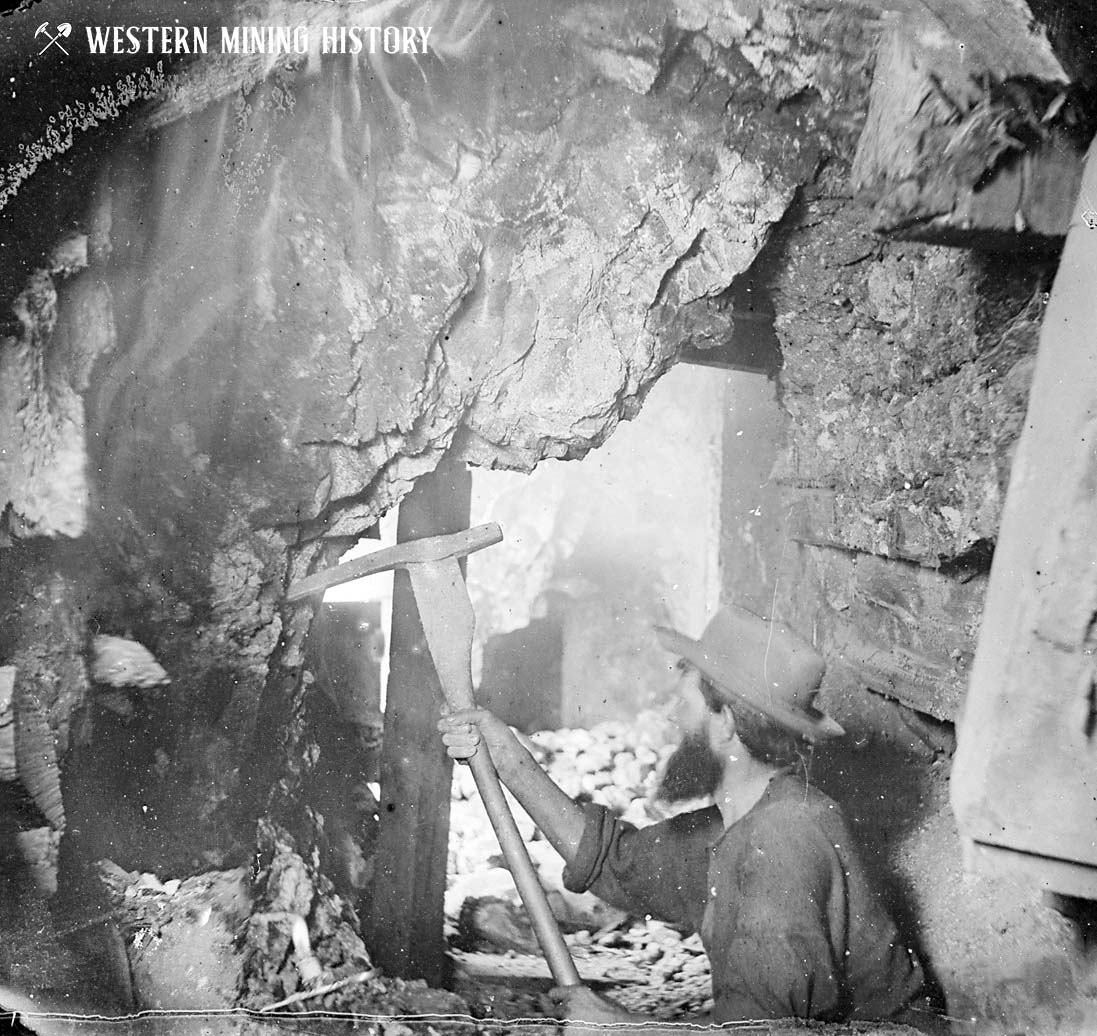
The following photo is another taken by Timothy O’Sullivan at a Comstock mine ca. 1867. The photo was taken using the “glare of burning magnesium for a flash of light”. This amazing image depicts two miners double jacking by candlelight. Double jacking is the process of drilling holes where one miner holds and turns a drill, while the other strikes it with a sledge hammer.
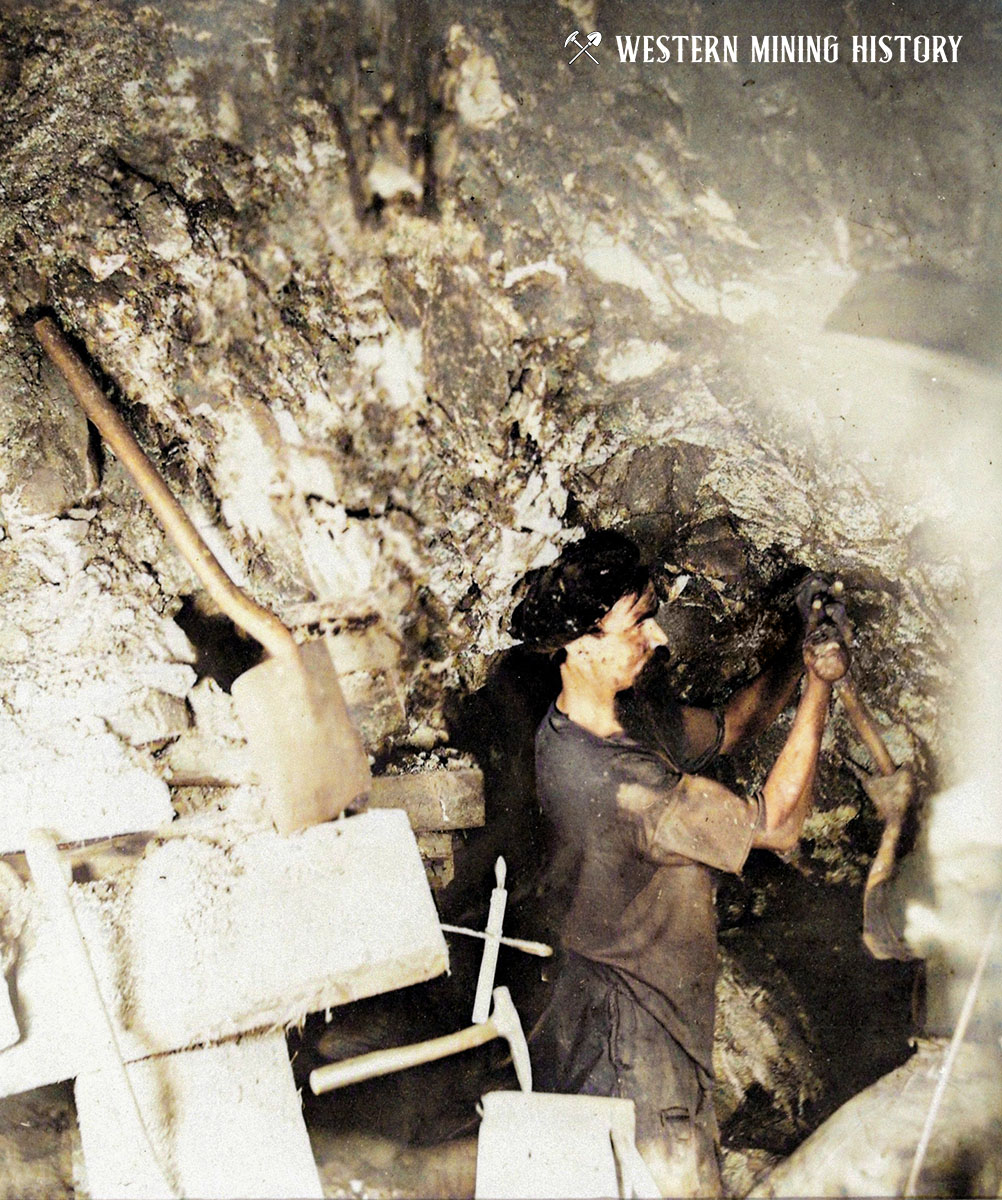
The following image shows a miner transferring ore from a bucket to an ore car deep in a Comstock mine.
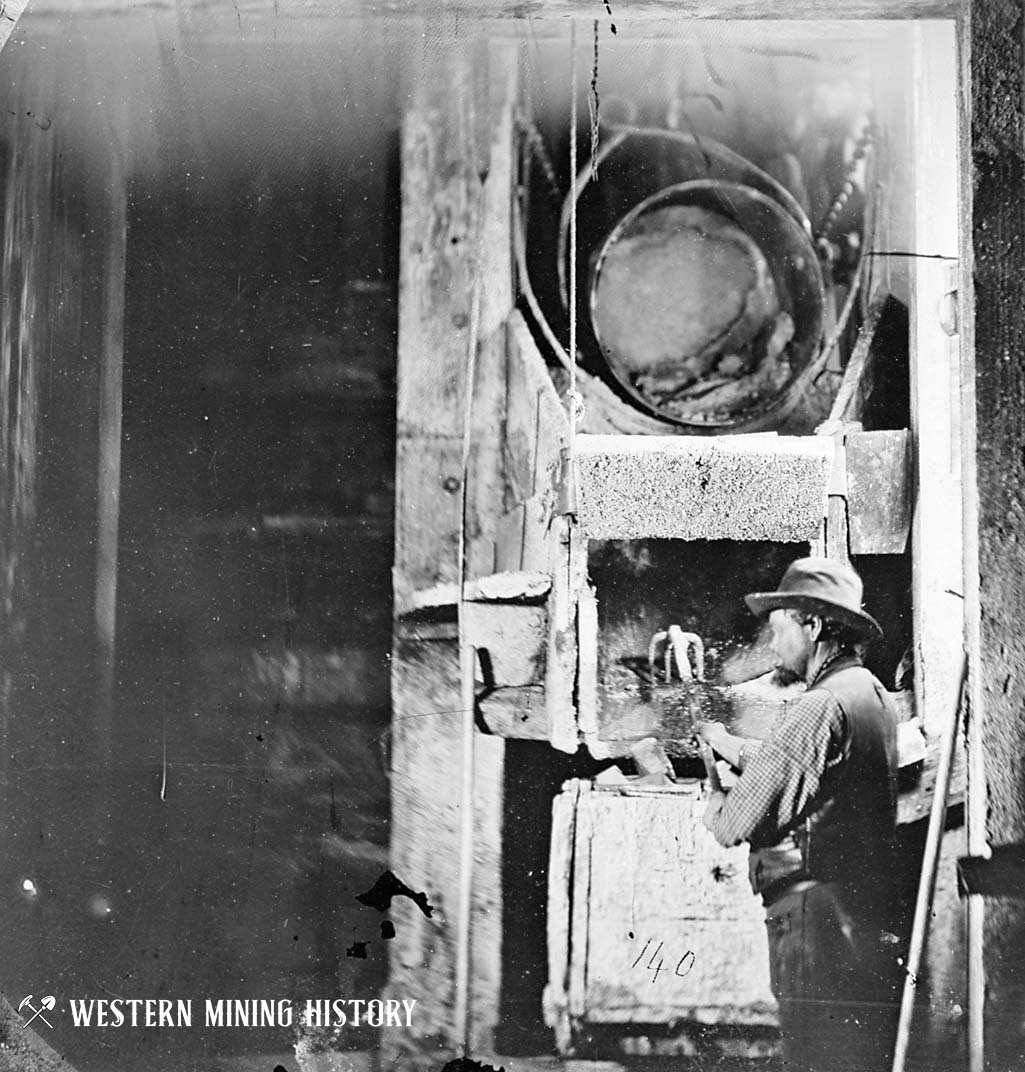
Of the many innovations that came out of Comstock mines, square set timbering was likely the most famous, and most impactful on mining operations throughout the world. Invented in 1860 by Phillip Deidesheimer, the square set method of timbering solved the problem of how to mine the enormous ore bodies of the Comstock mines while stabilizing the resulting empty chambers, or “stopes”, that were left behind. The illustration below demonstrates how square sets worked.
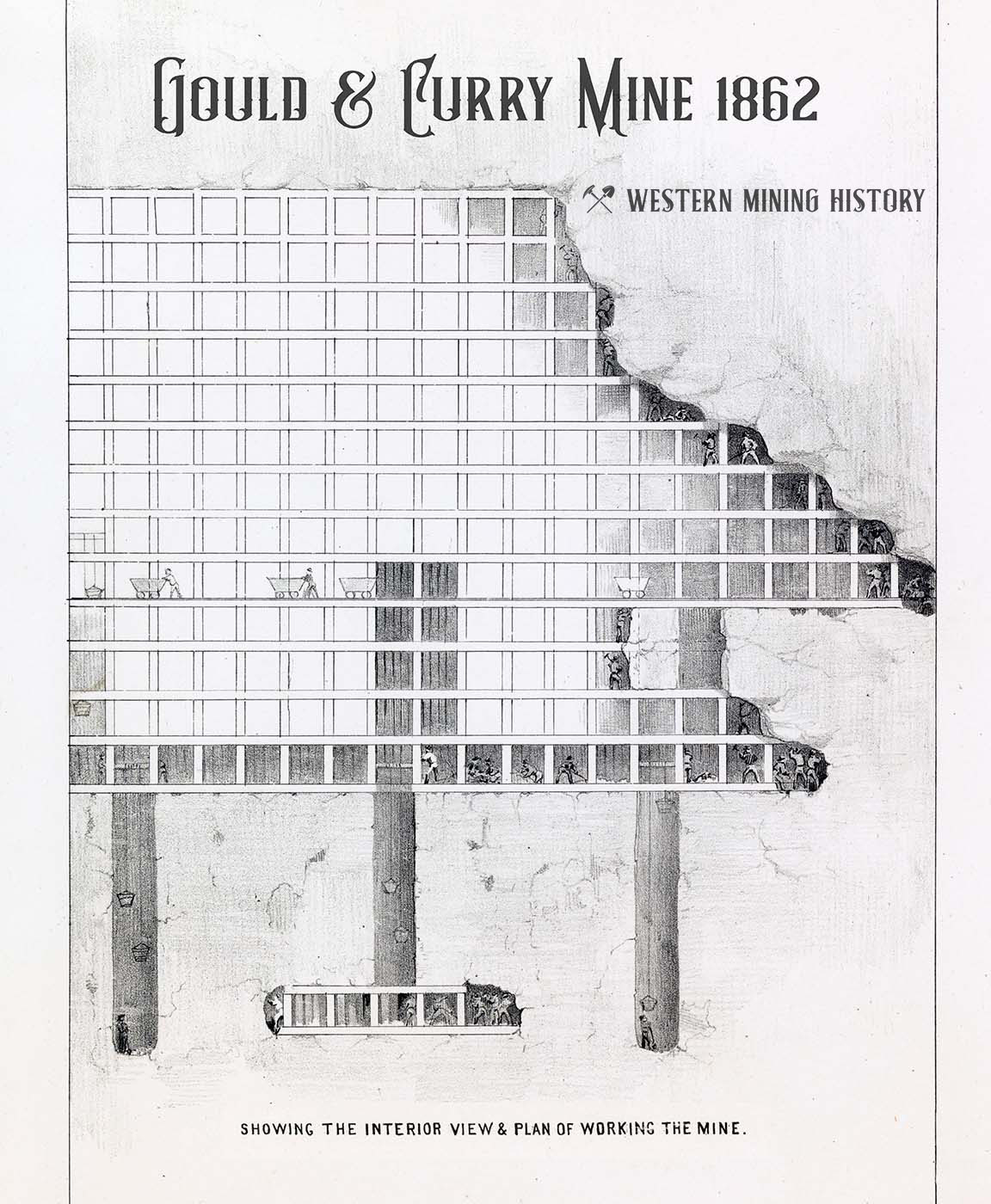
This image of miners pushing ore cars has some interesting details – note the miner in the front is holding a candle. To the right of him is a stack of milled timbers for use in square sets.
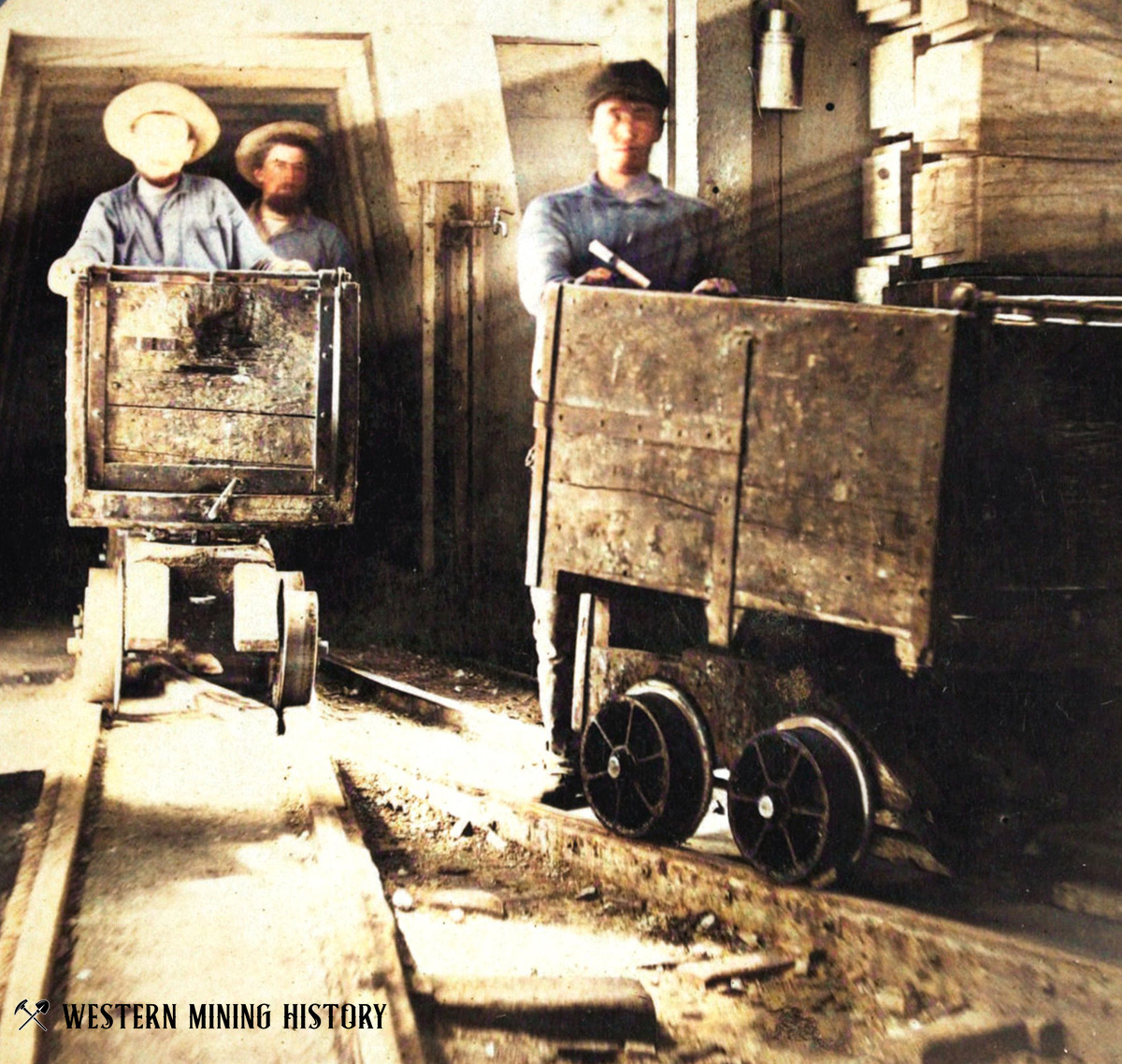
The Comstock Mills
The Comstock mines produced vast quantities of ore that needed to be milled. Over 200 mills operated in the various sub-districts of the Comstock Lode, most of them built during the 1860s and 1870s. One aspect that makes this so remarkable is that many of these mills were built well before there were any railroads in the territory. The equipment was hauled by freight wagons over rough wagon roads, over the Sierra and through the difficult terrain of western Nevada.
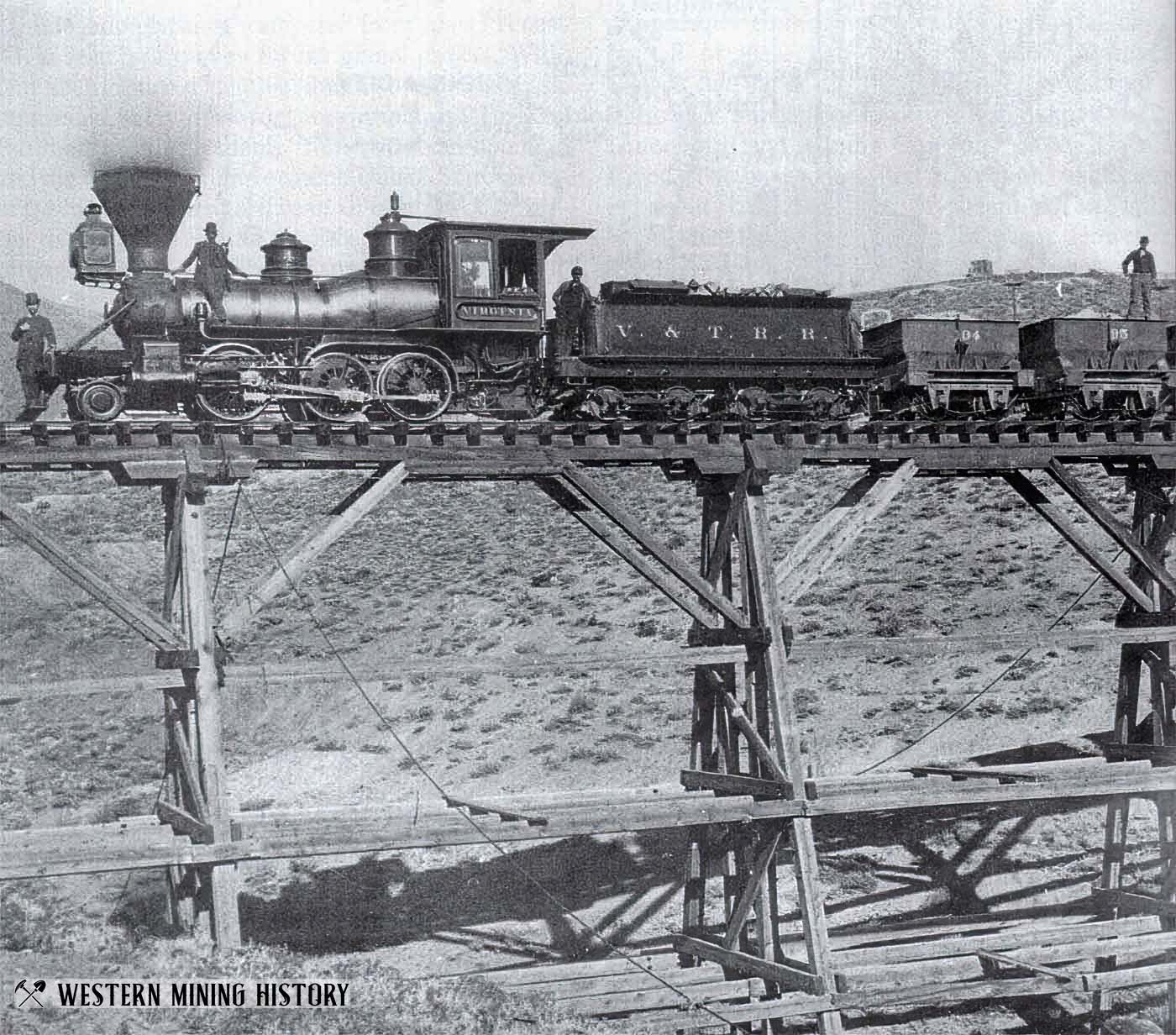
The Consoildated Virginia Mill burned down during the great Virginia City fire of 1875, but was quickly rebuilt. The mill cost $300,000 to build and featured 60 stamps, 40 pans, and a capacity of around 250 tons per day.
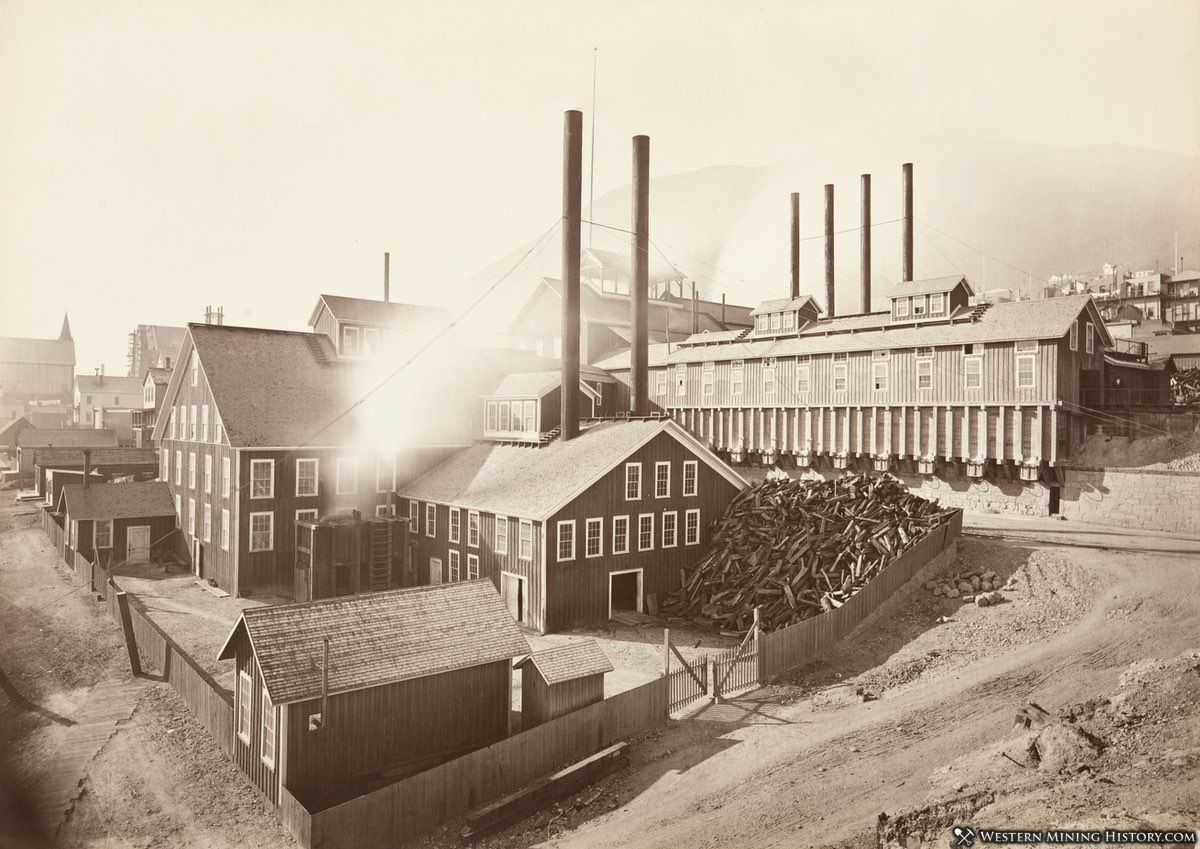
Built in the early 1860s, the Nevada Mill was originally known as the Empire. By 1867 the name had changed to the Nevada Mill, and that year it was reported as having 21 stamps, a capacity of 40 tons per day, and processed ore from the Chollar-Potosi Mine.
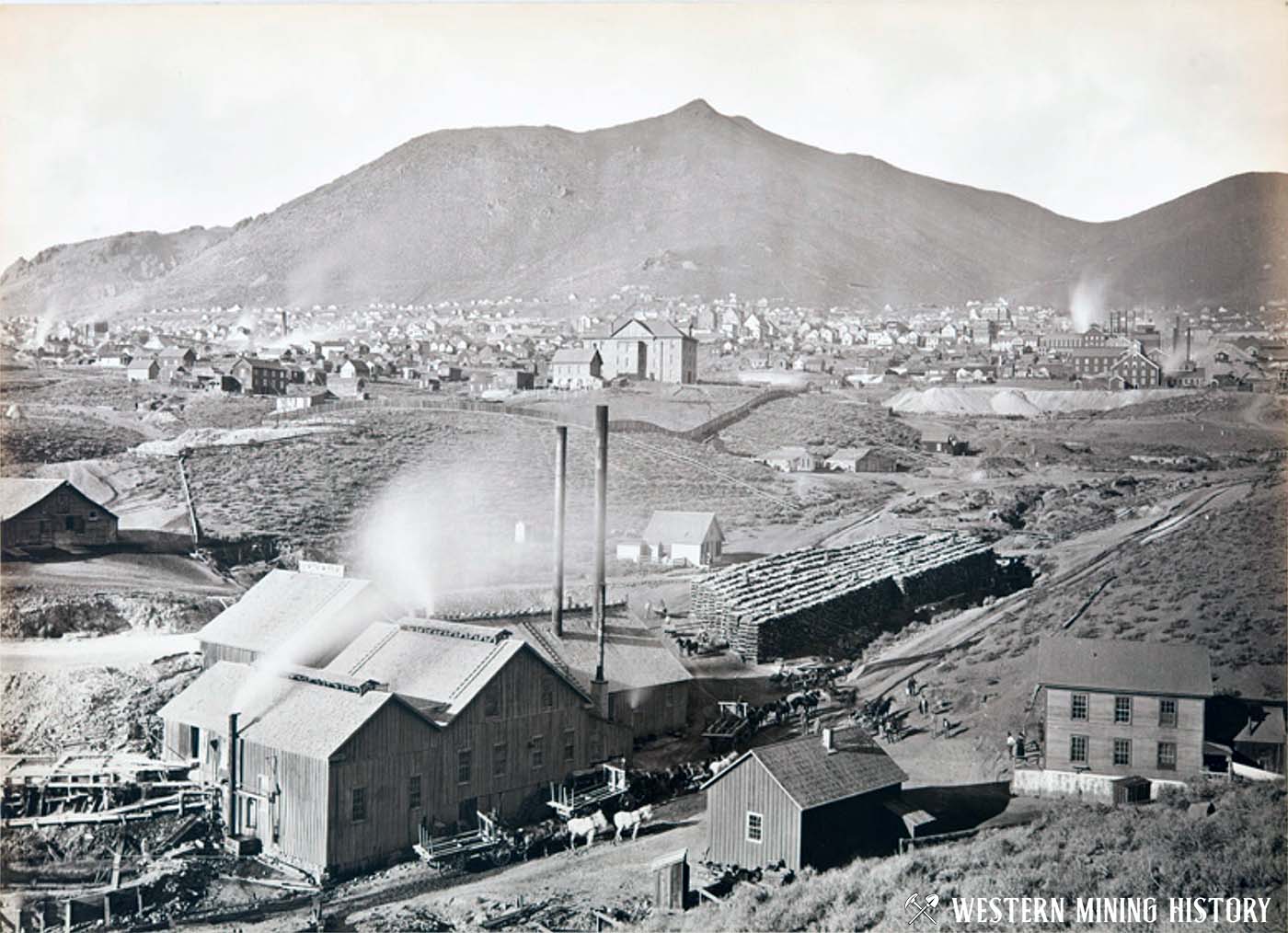
The Gould & Curry Mill was a massive facility built at the intersection of Six and Seven Mile Canyons, just south of Virginia City. In 1866 the mill was reported to have 80 stamps, over 40 pans, and a capacity of 100 tons per day.
The extravagance of the mill was detailed by Eliot Lord in his 1883 book Comstock Mining and Miners: “The extraordinary mill of the Gould & Curry Company was, however, the most conspicuous monument of inexperience and extravagance ever erected in a mining district.”
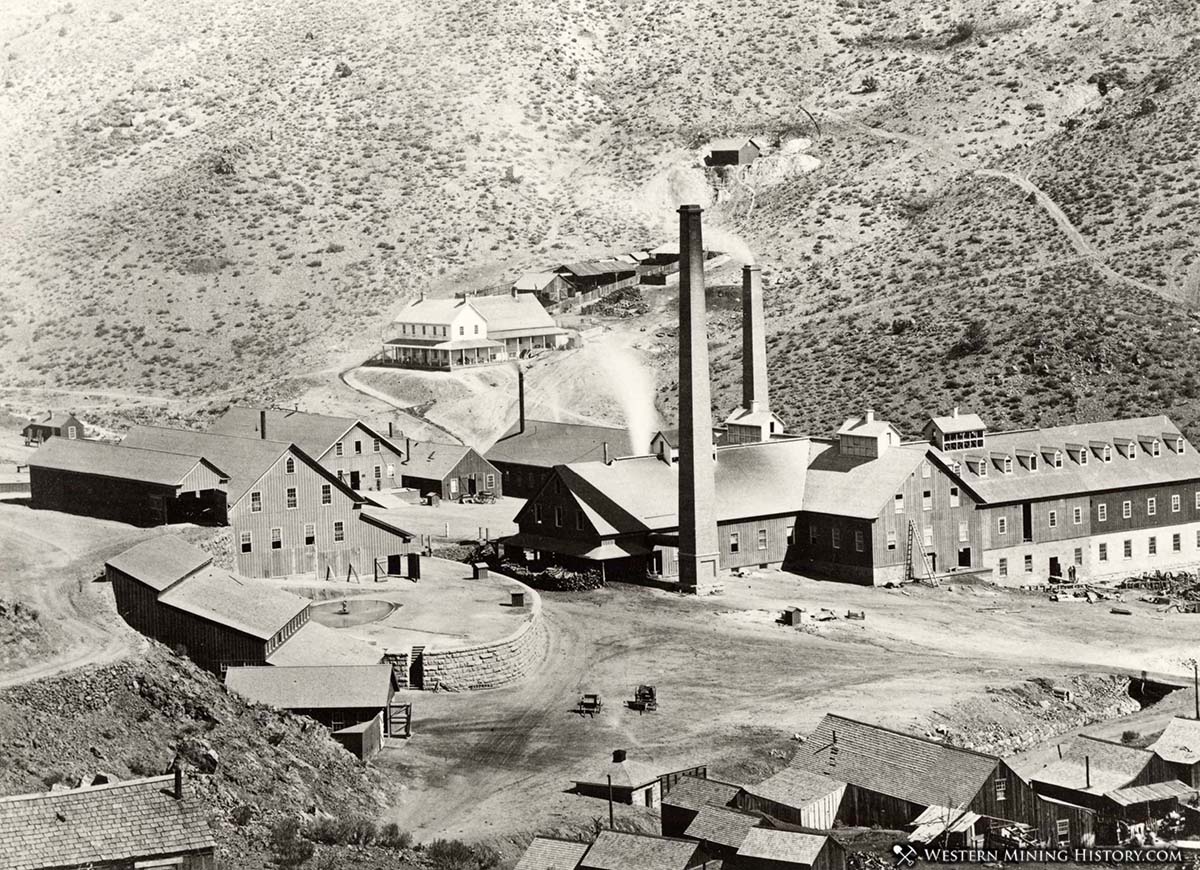
The Omega Mill was built in 1876 at the site of the Gould & Curry Mill. It was reported as having a 100 ton per day capacity. Note in the photo below that some of the foundations of the Gould & Curry are visible.
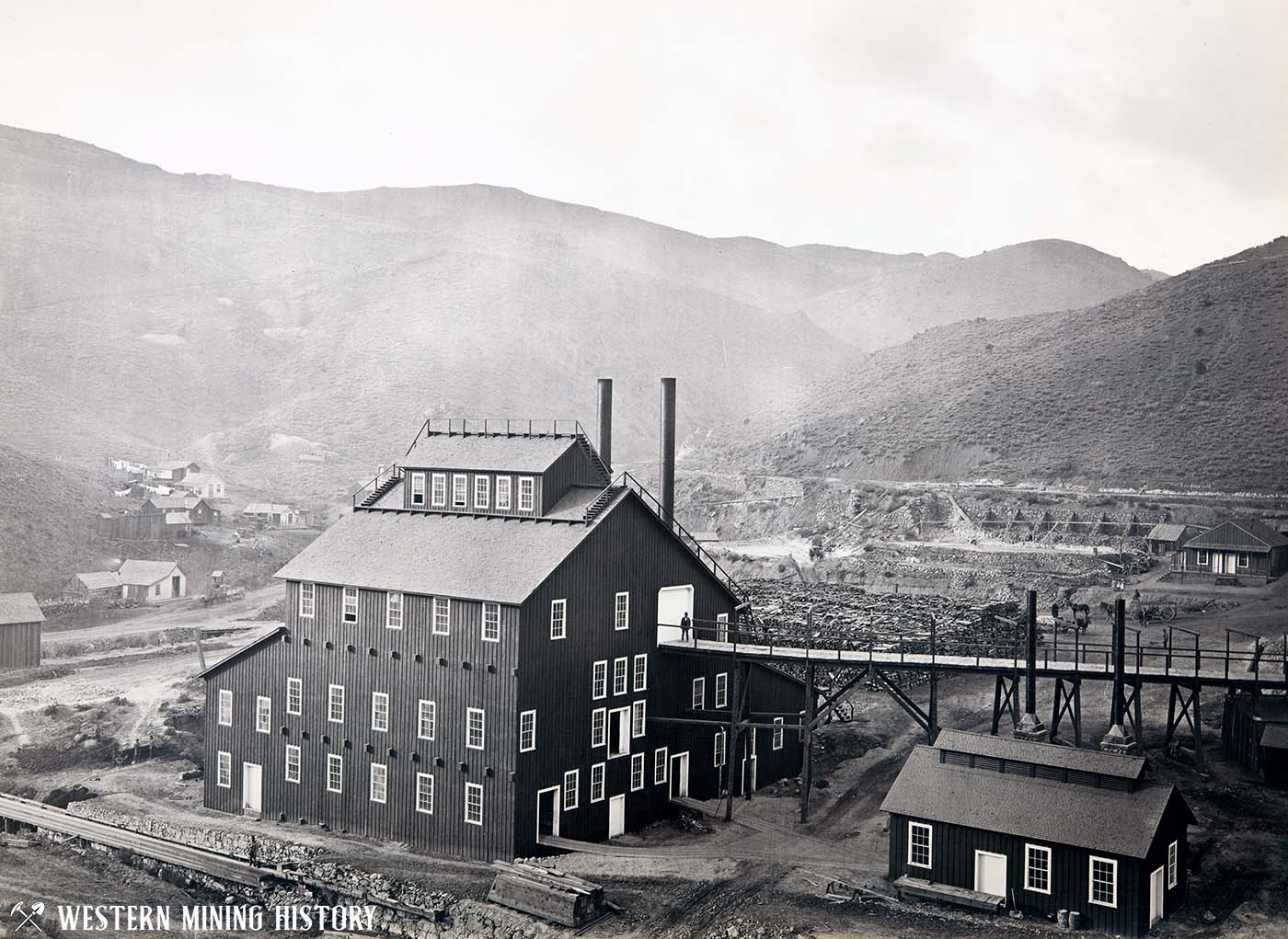
Built in the early 1860s, the Winfield Mill had 20 stamps and a capacity of 20 tons per day. By the early 1870s it had been upgraded to a capacity of 50 tons per day and processed ore from the Chollar-Potosi Mine.
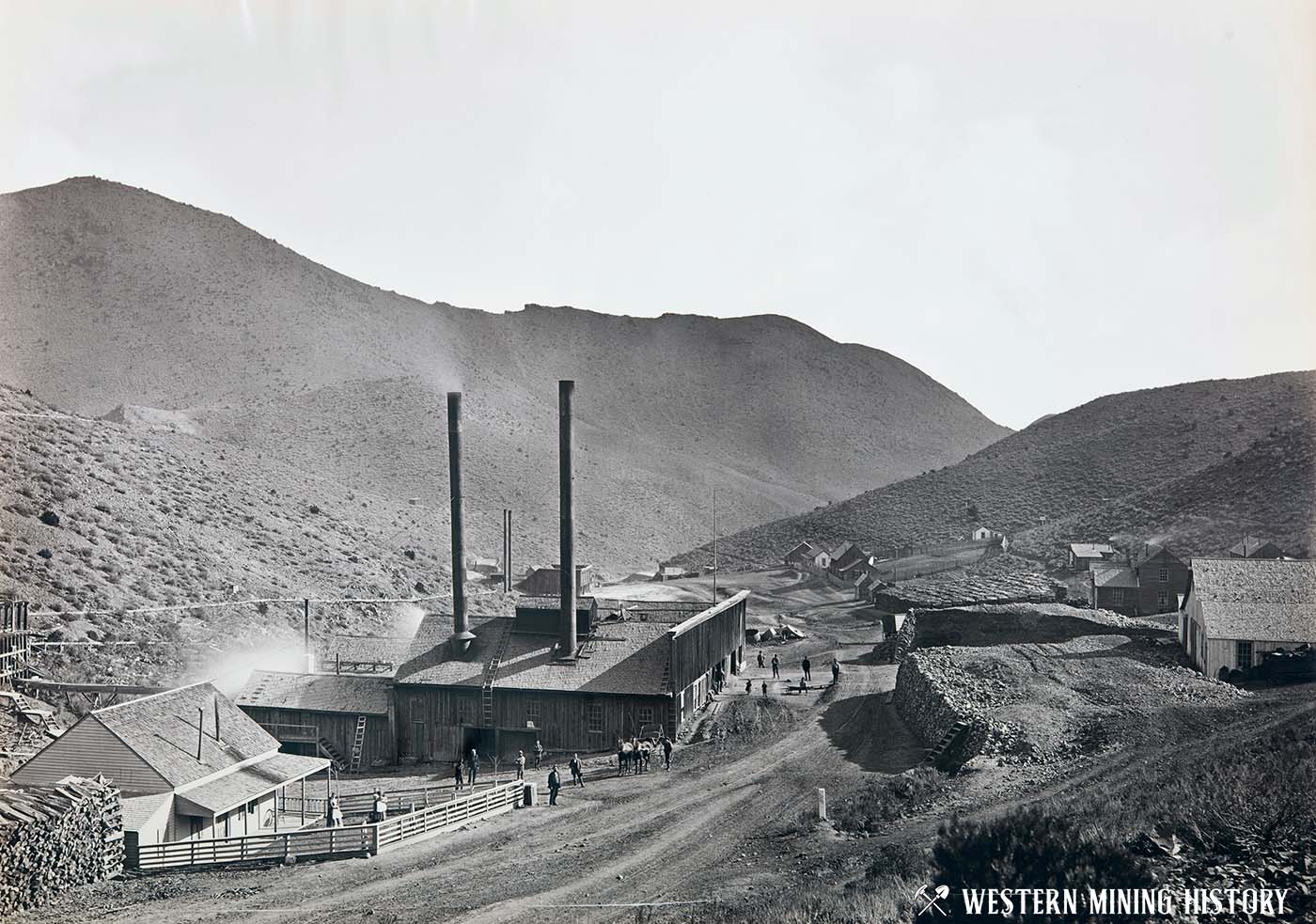
Gold Hill was described as having a continuous line of mines and mills from top to bottom of the town. The photo below shows three of the more prominent early milling operations.
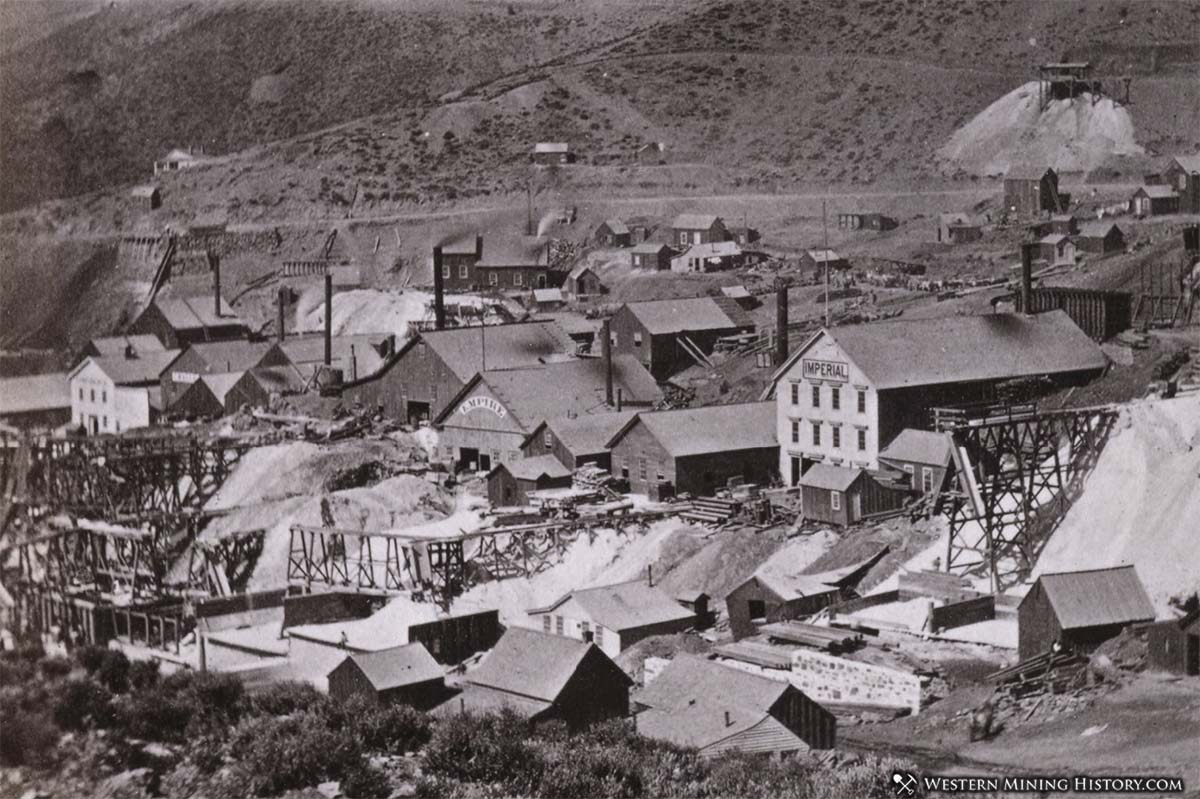
The Trench mill was built in 1860 and originally known as Sparrow & Trench. This was one of the larger operations at the time, reported to have cost $40,000 to build and having numerous buildings in the complex. In 1865 it was listed as having 20 stamps with a capacity of 30 tons per day. In 1869 this mill was purchased by John Mackay and James Fair, men that would later be known as two of the Comstock’s “Bonanza Kings”.
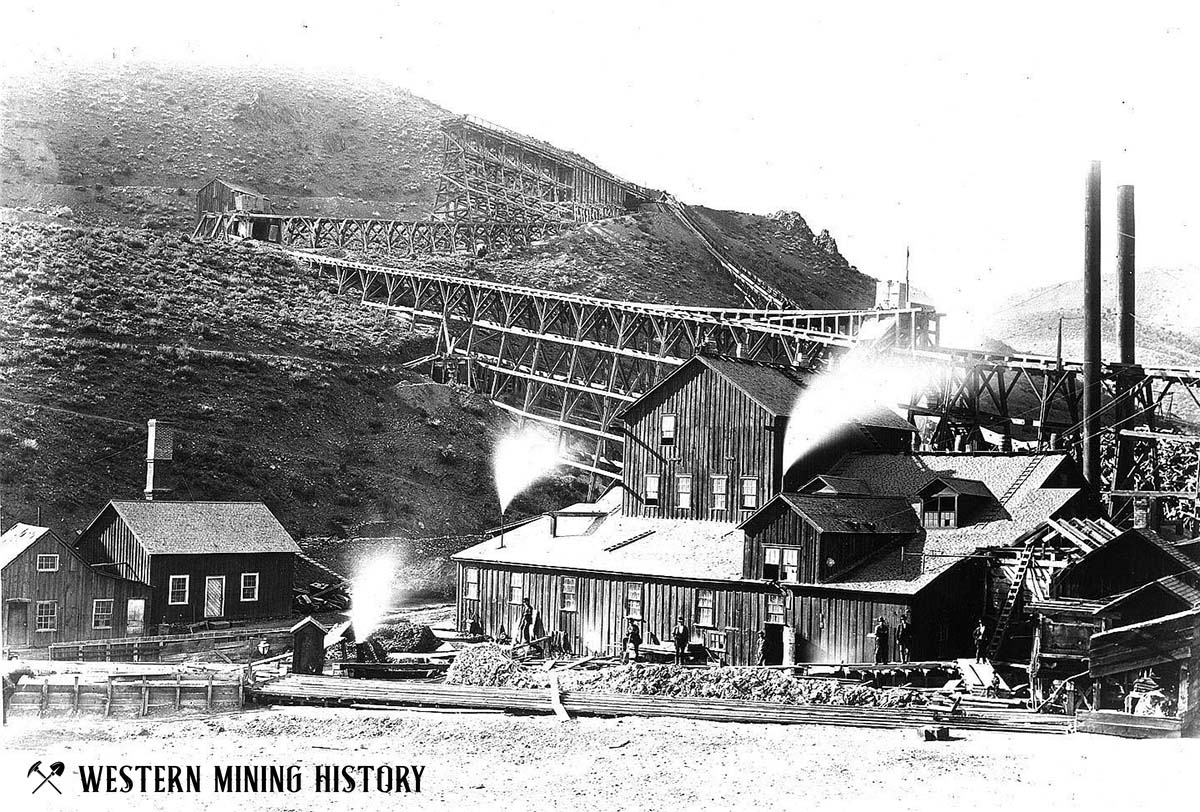
The Pioneer Mill at Silver City was one of the earliest steam-powered mills built to process Comstock ores.
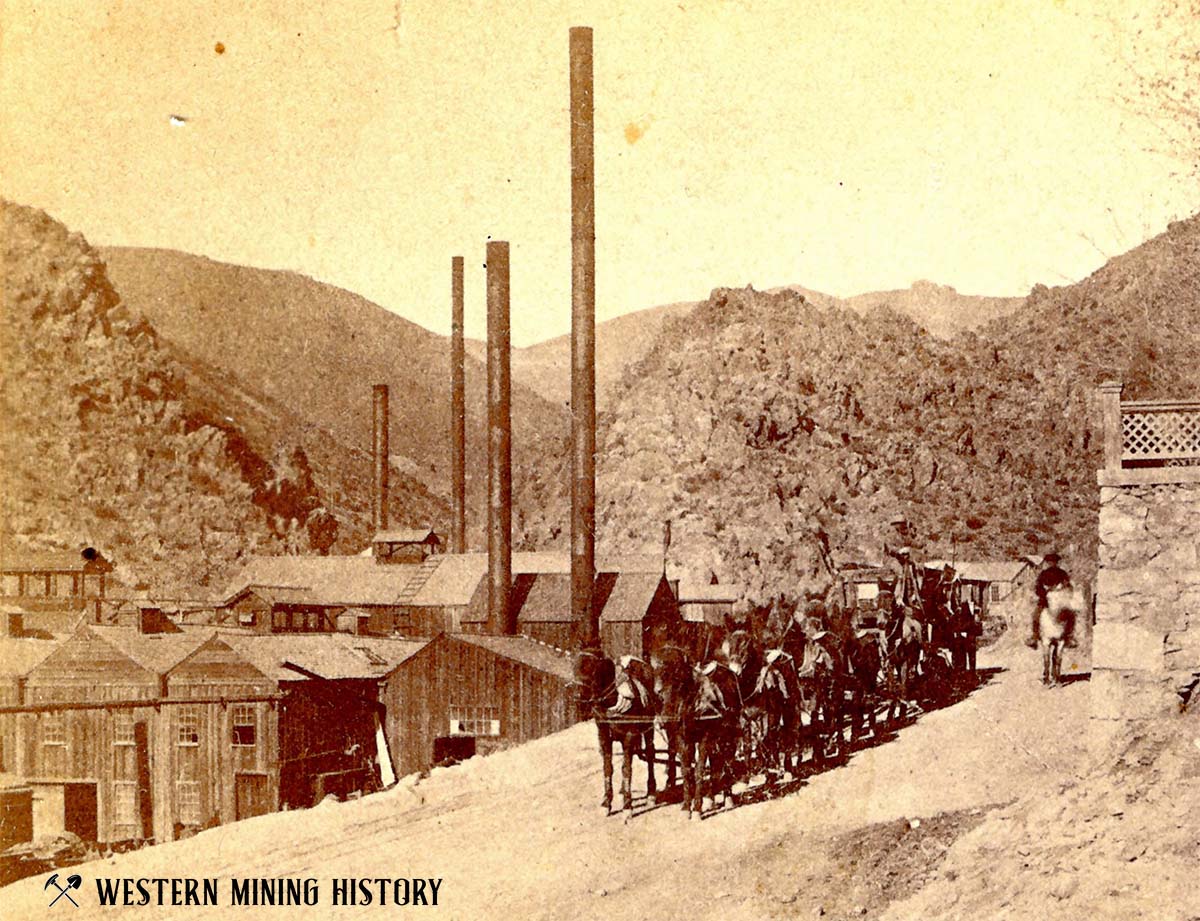
Constructed in 1864, the Brunswick Mill was described as one of the Carson River area’s largest mills. It was initially a water-powered mill with 8 stamps, but by the early 1870s it had been expanded to a total of 56 stamps, with a capacity of 150 tons per day. The mill continued to operate through the late 1880s.
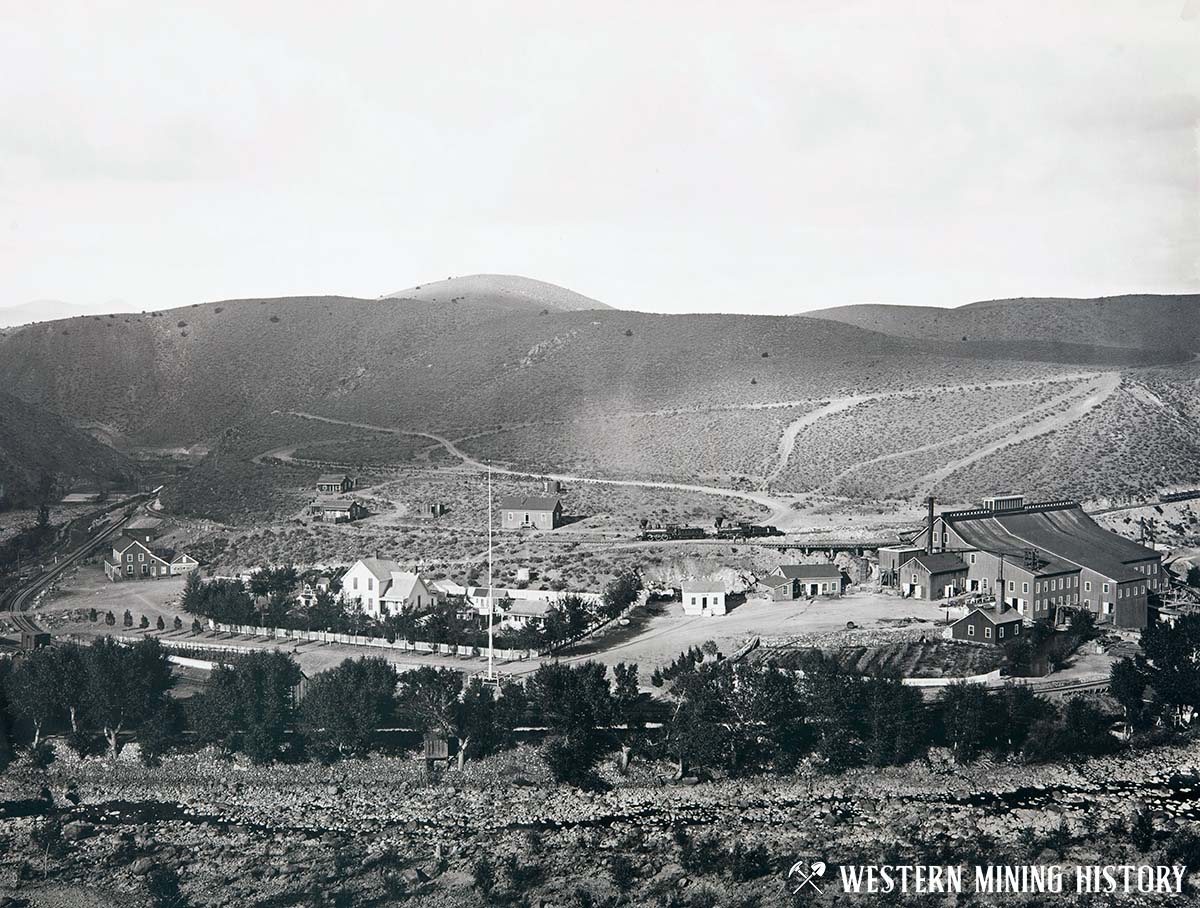
Additional details on the Comstock Lode’s many mills is available at the Members only article Mill Locations of the Comstock Lode.
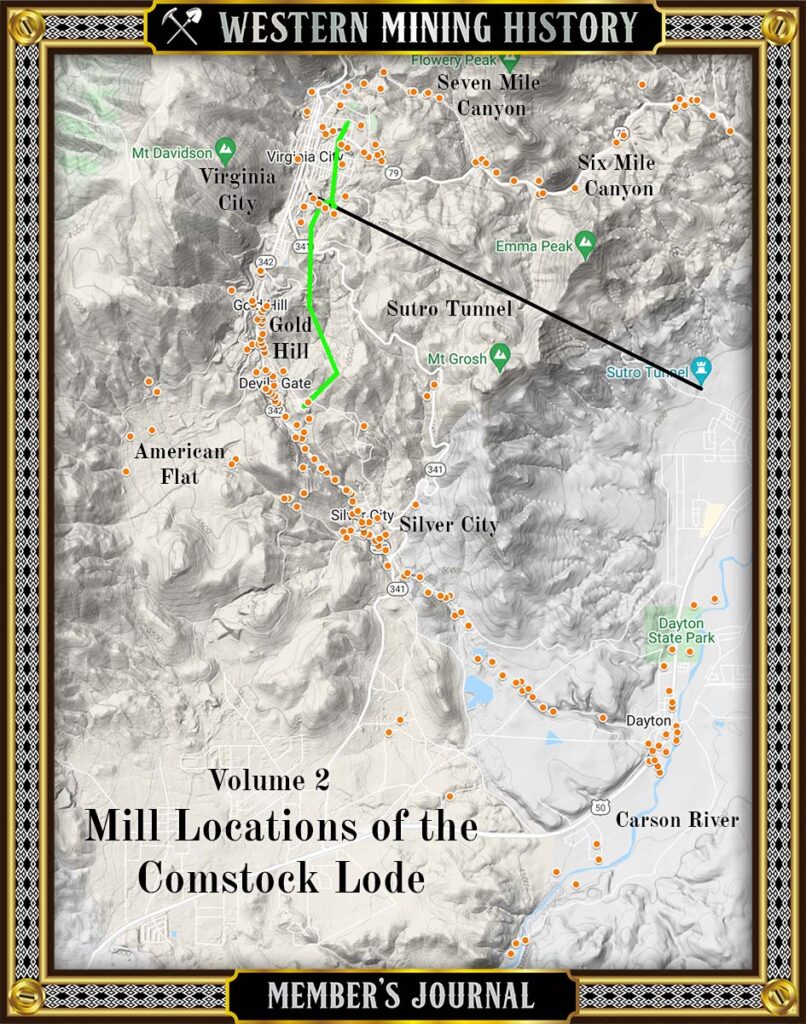
More Photo Collections from Western Mining History
The following collections capture more of the West’s amazing mining history:
A Collection of Arizona Mining Photos
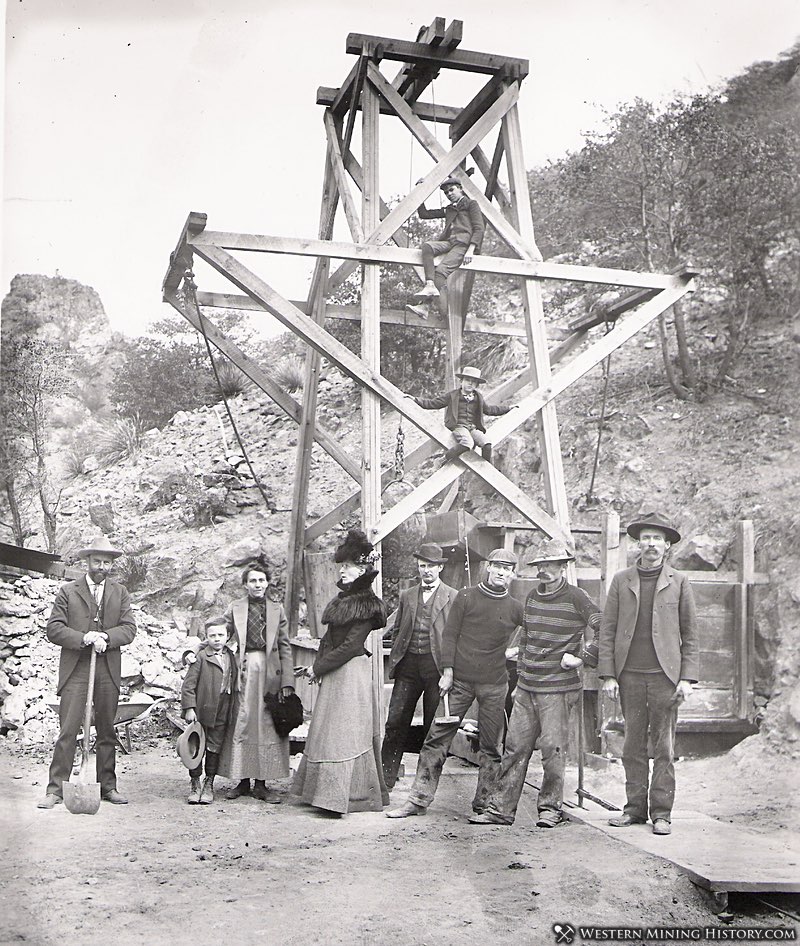
A Collection of Arizona Mining Photos highlights some of the best historic scenes from various Arizona districts during the peak mining years between the 1870s and the 1920s.
50 Incredible Photos of Colorado Mining Scenes
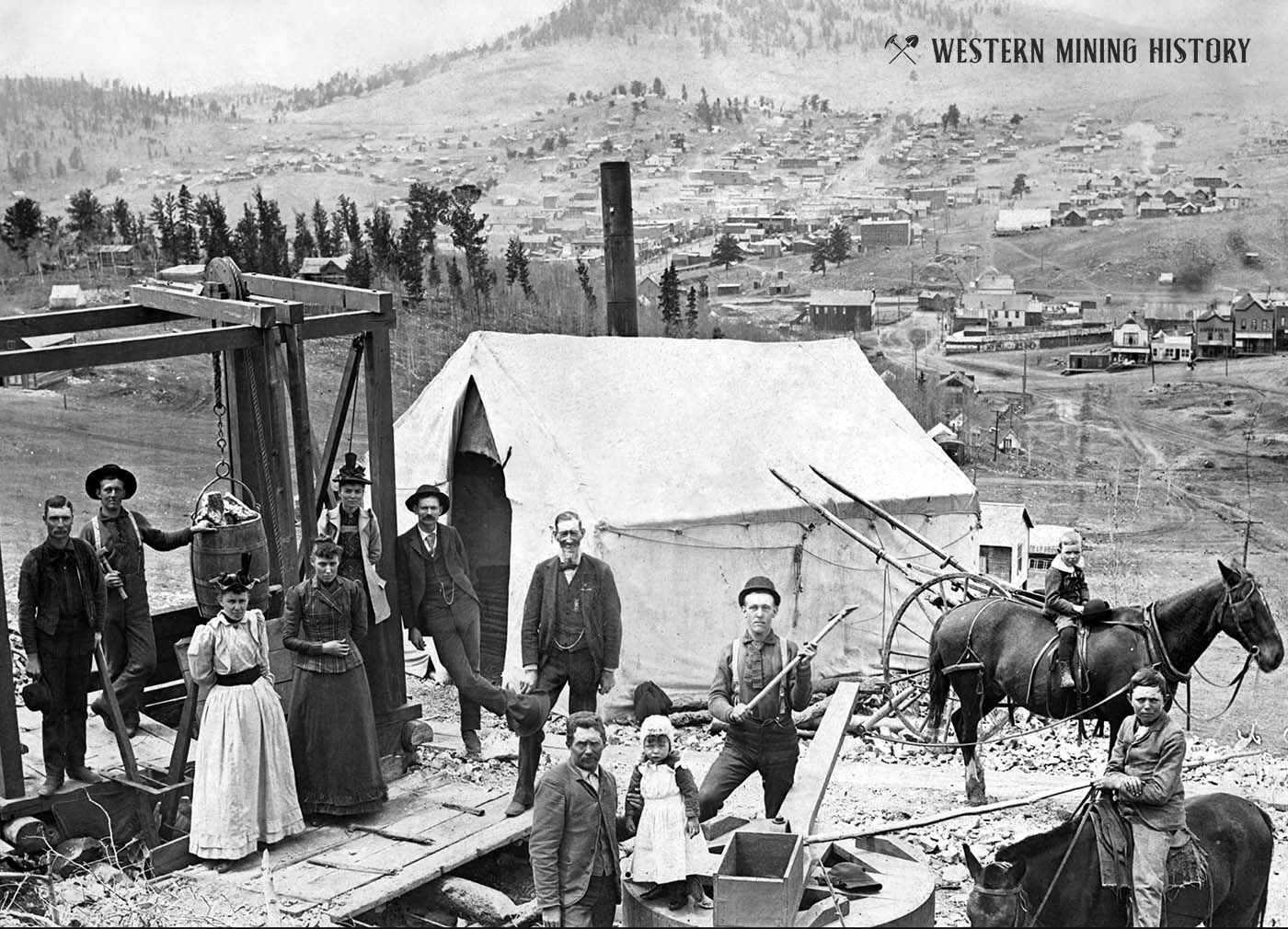
Colorado’s spectacular scenery and the richness of the state’s mines attracted many of the top photographers working at the time. These are some of the most incredible mining scenes from the state of Colorado: 50 Incredible Photos of Colorado Mining Scenes
Best Historical Photos: Colorized Mining Scenes
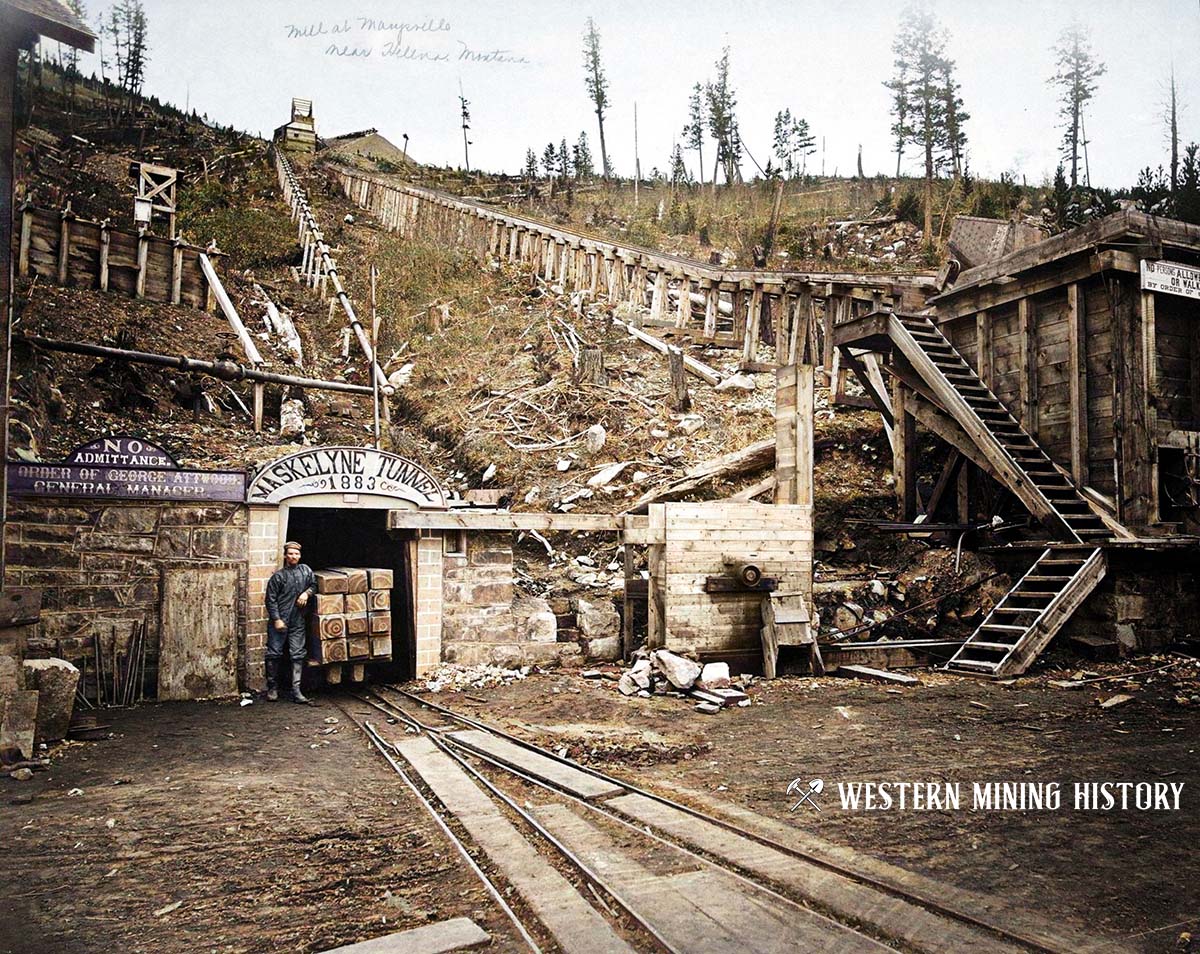
This collection images highlights some of the best colorized photos of historic western mining scenes. Included are mines, miners, historic mining towns, and related scenes: Best Historical Photos: Colorized Mining Scenes
A Collection of Nevada Mining Photos
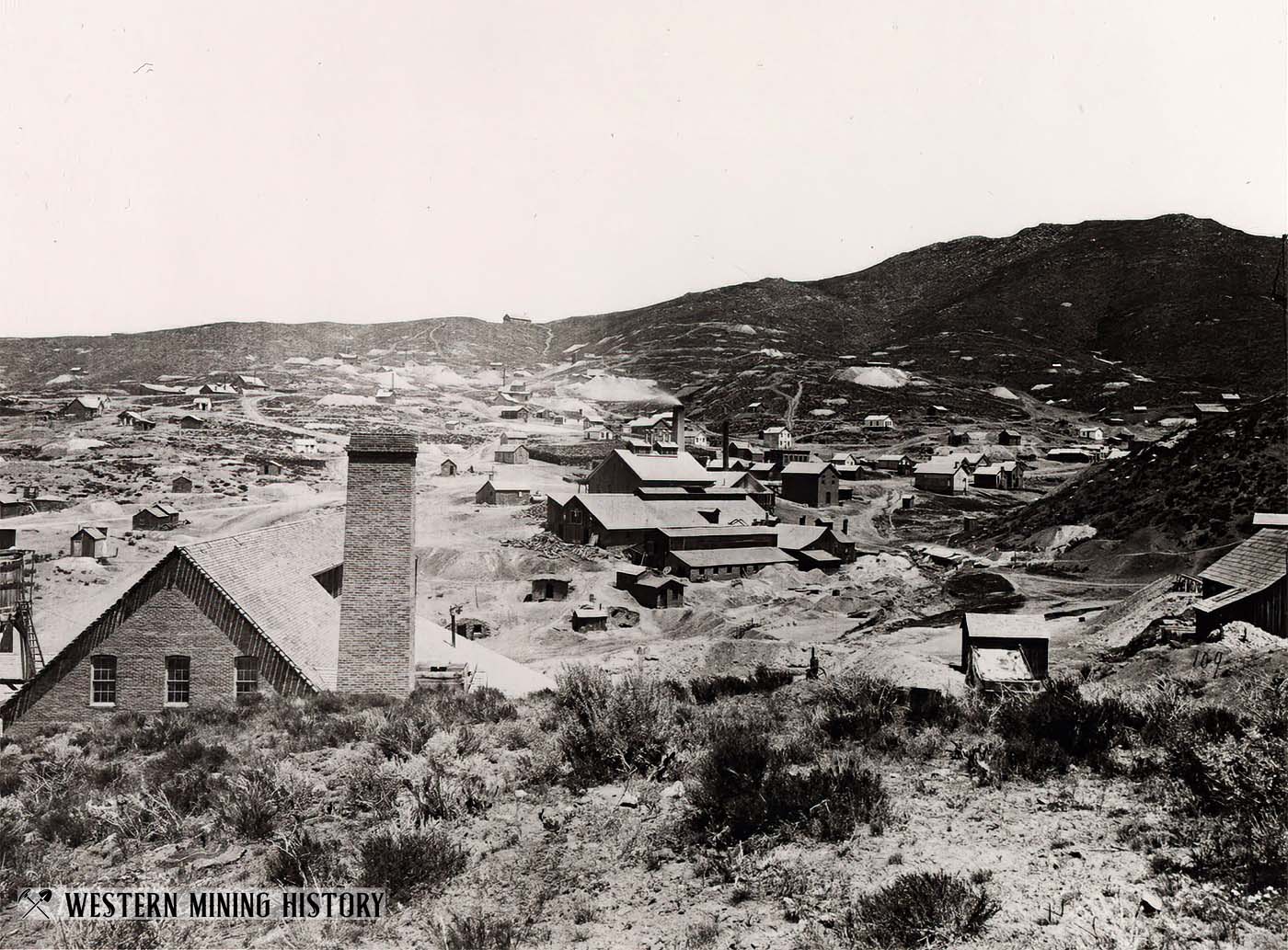
The first mines in Nevada were discovered in the 1850s, and by the 1860s new districts were being discovered throughout the state. Nevada would first be known as the “Silver State” but would eventually become the largest gold producing state in the Nation. These are some of the best historical photos from Nevada’s notable mining districts: A Collection of Nevada Mining Photos